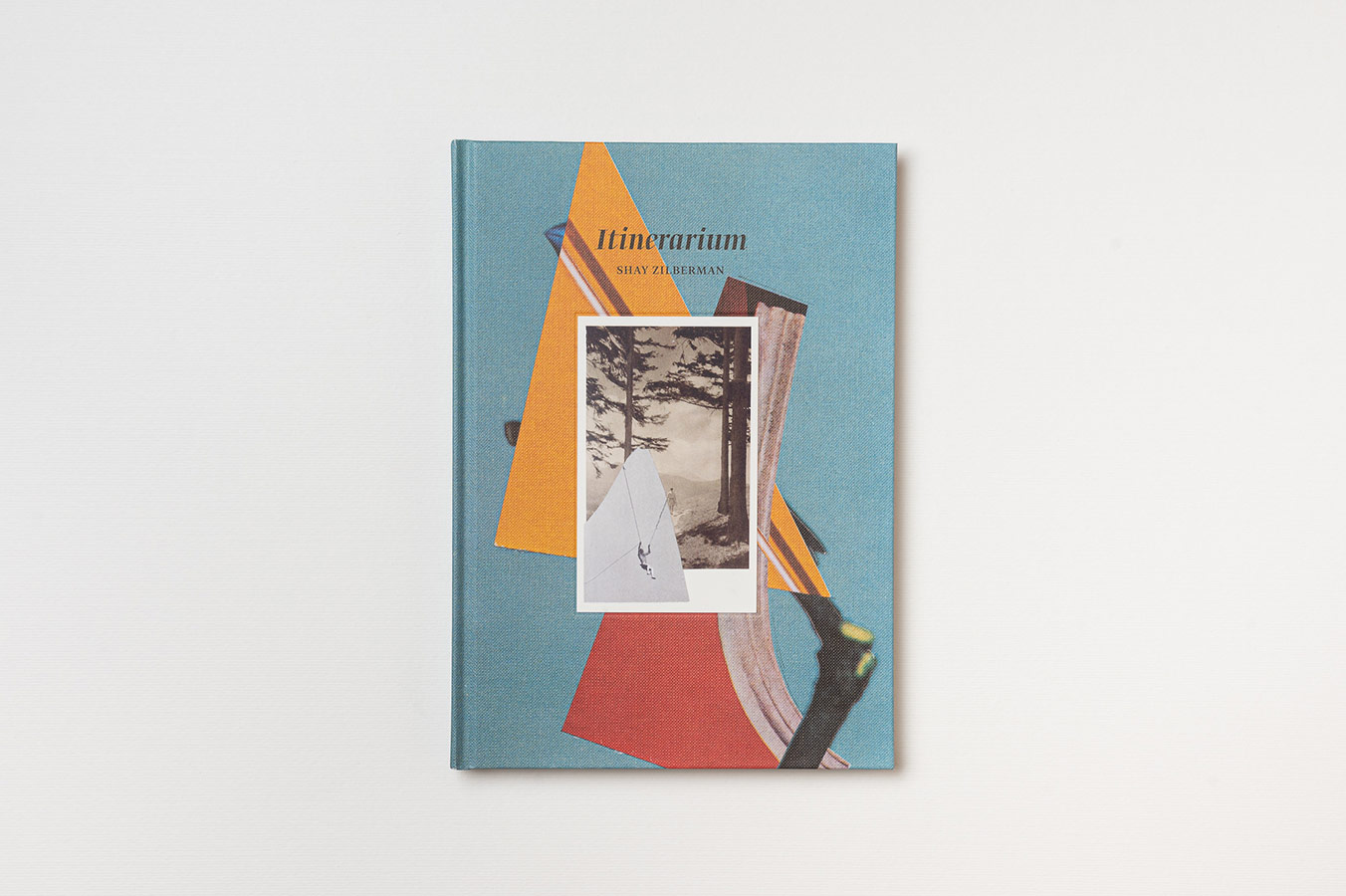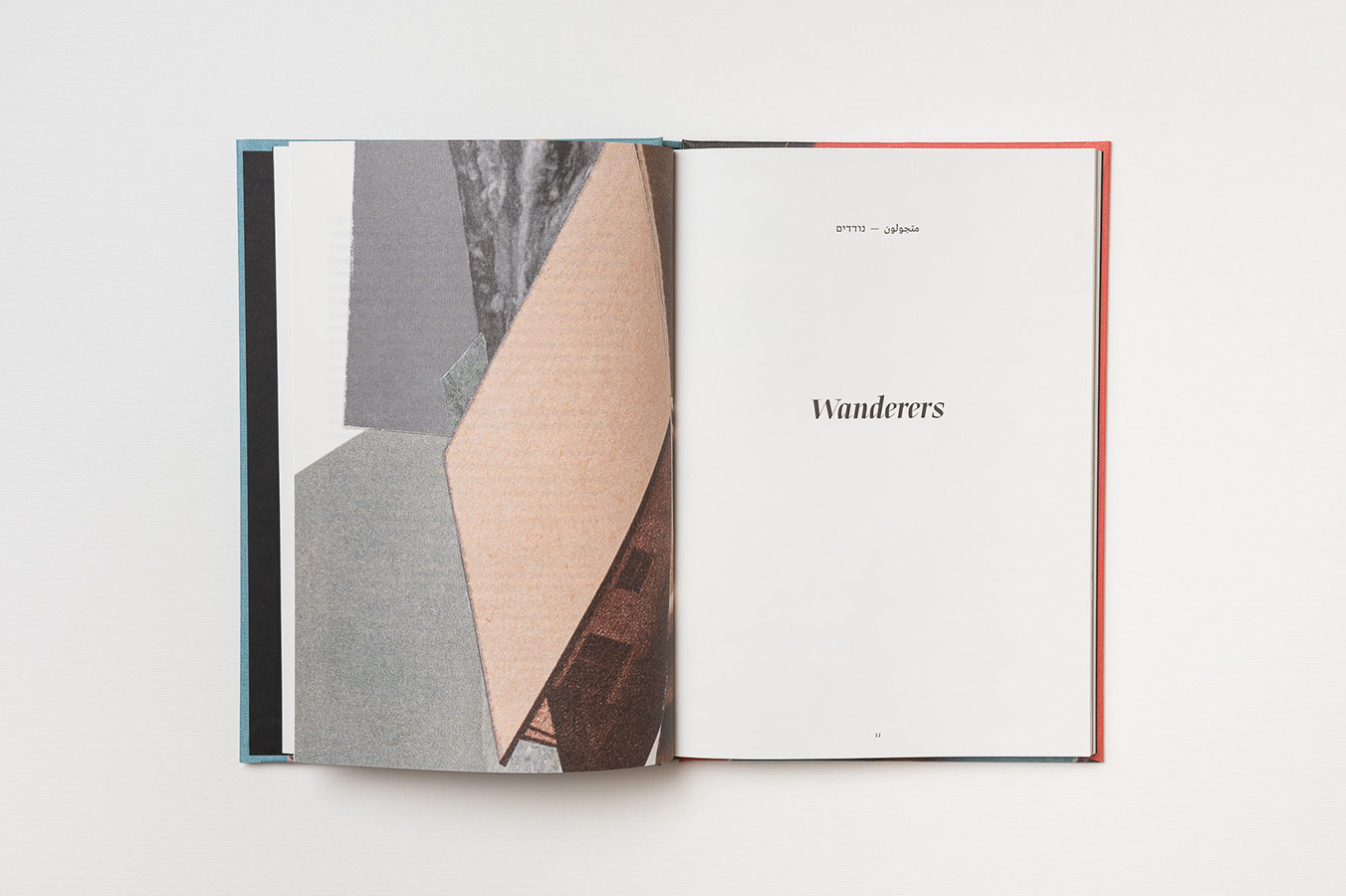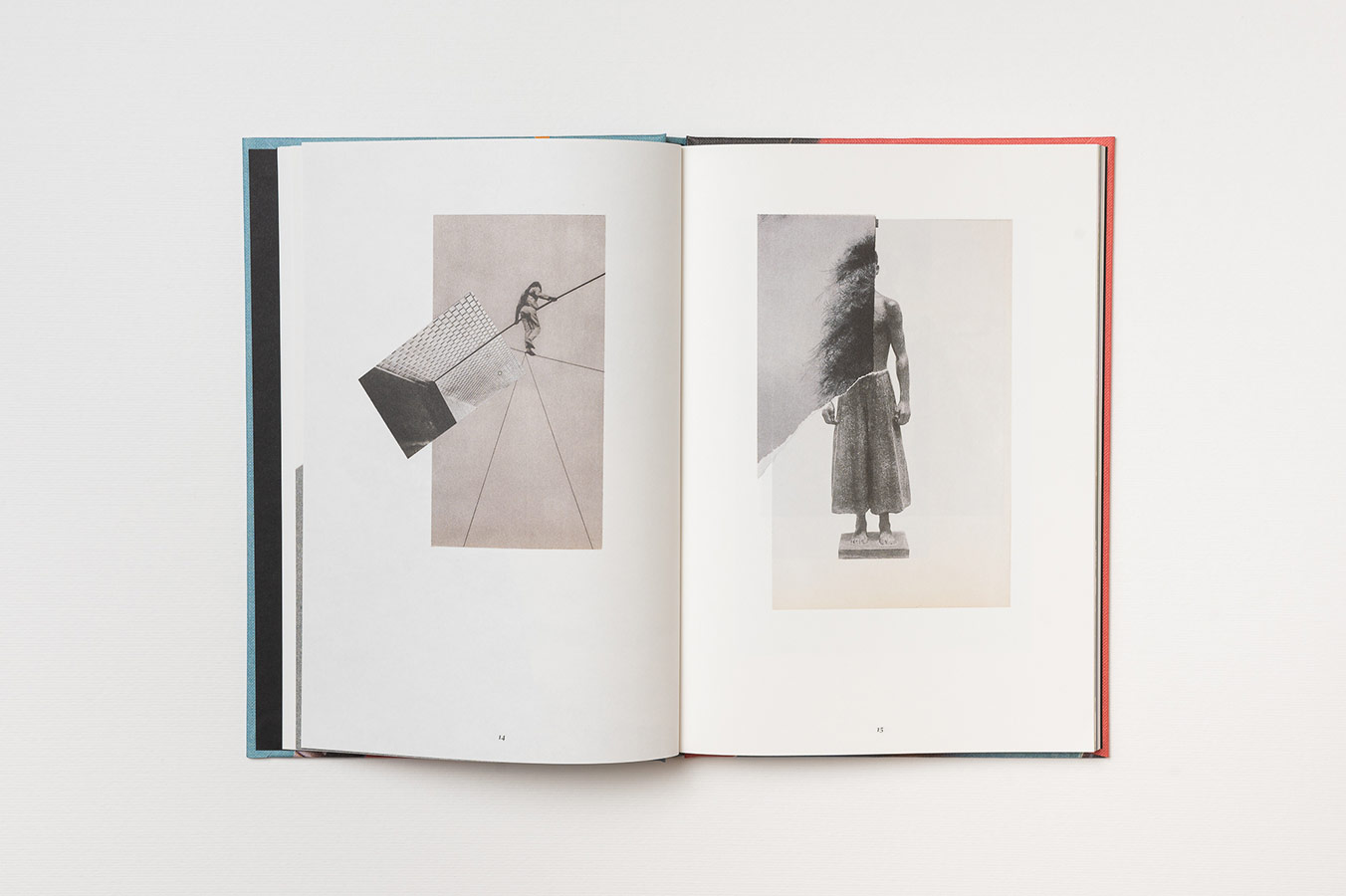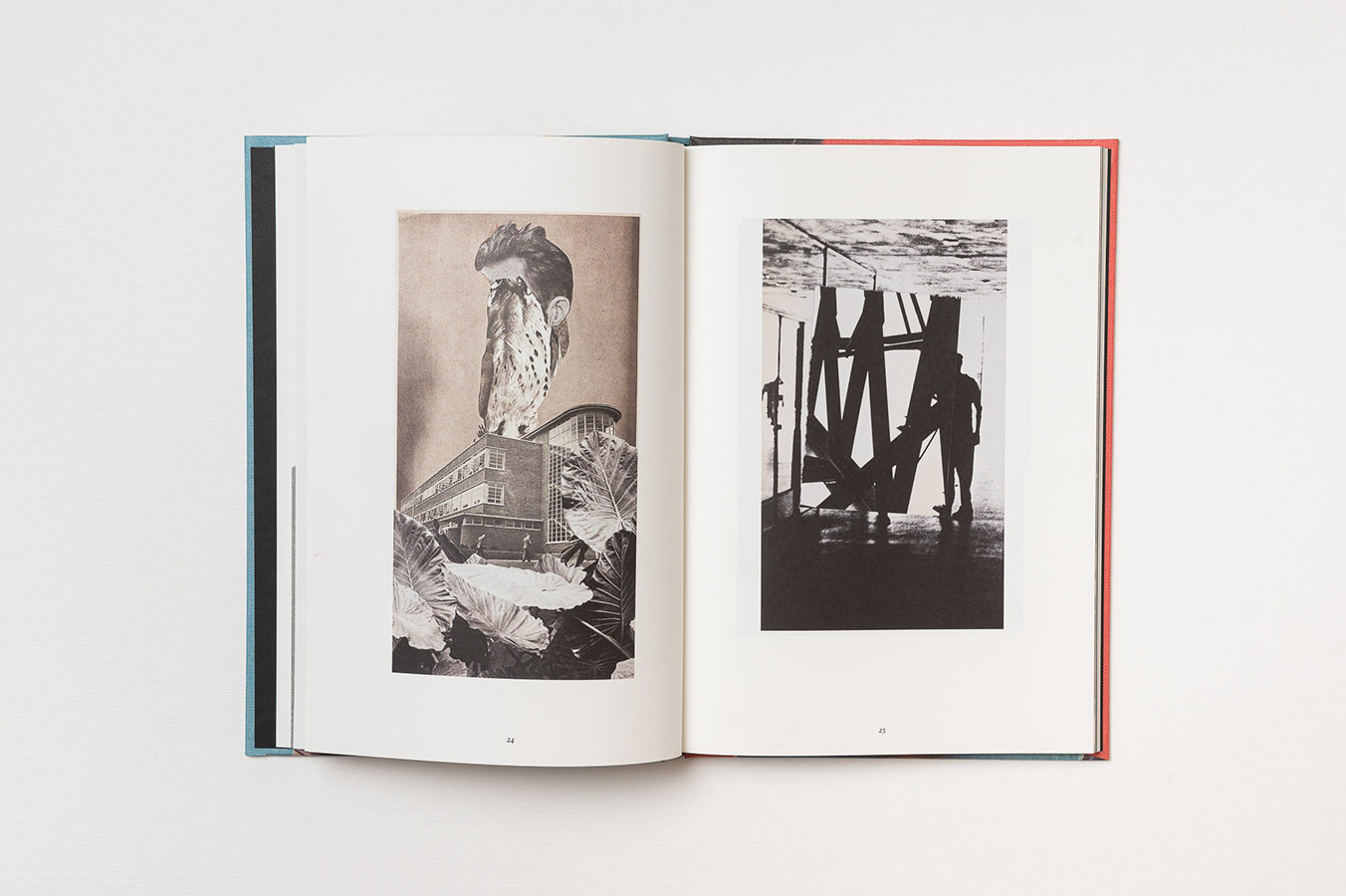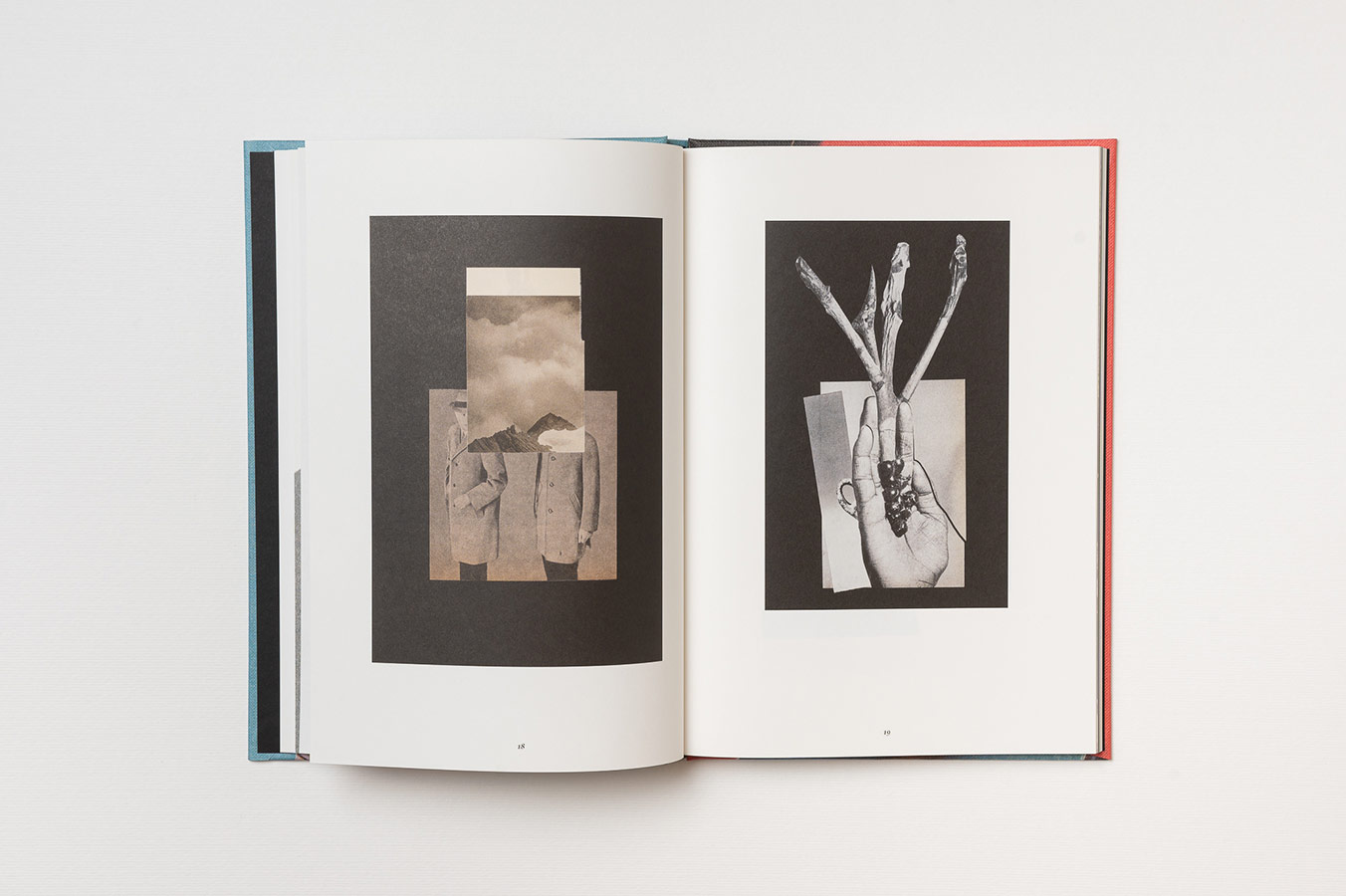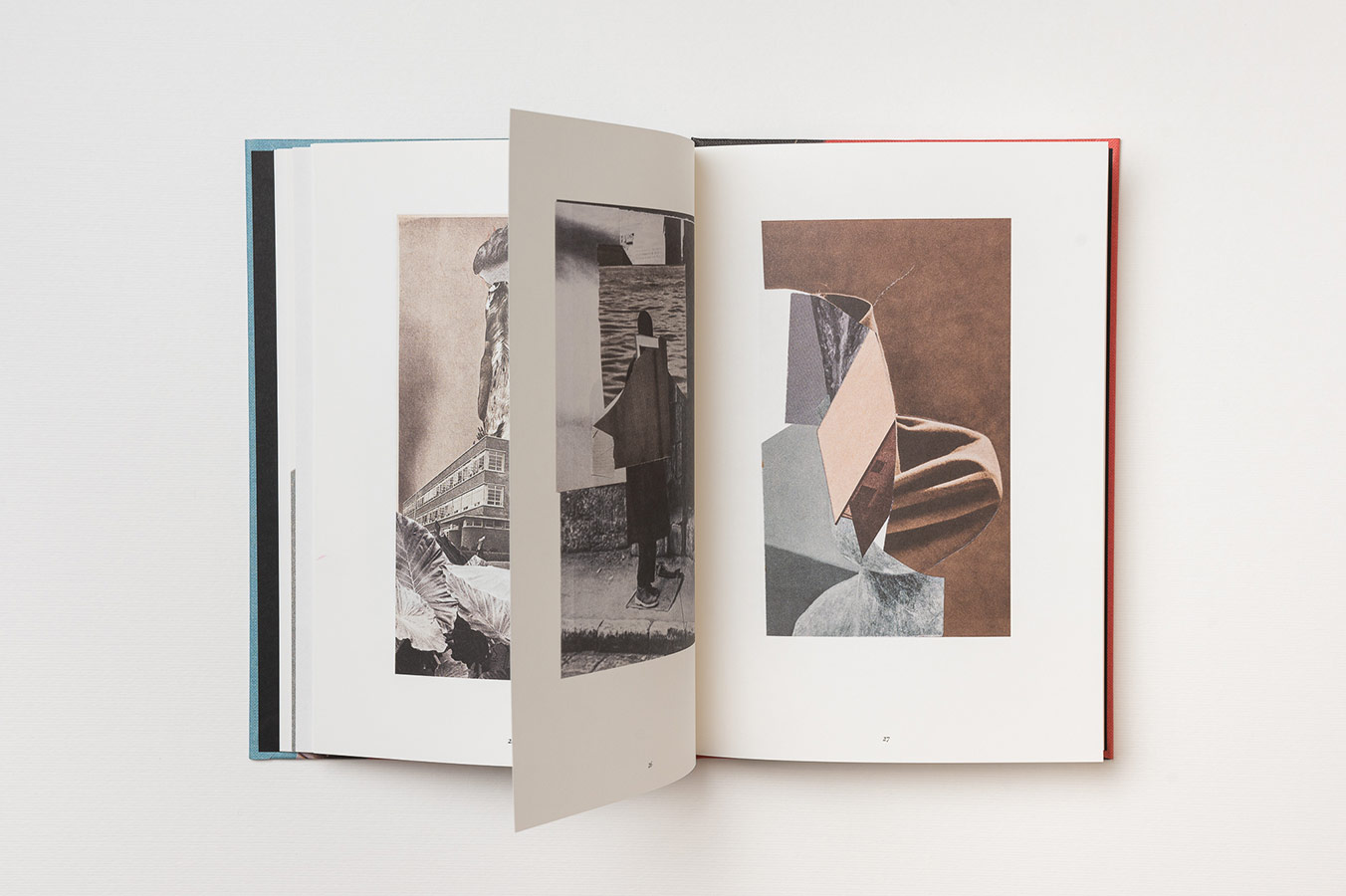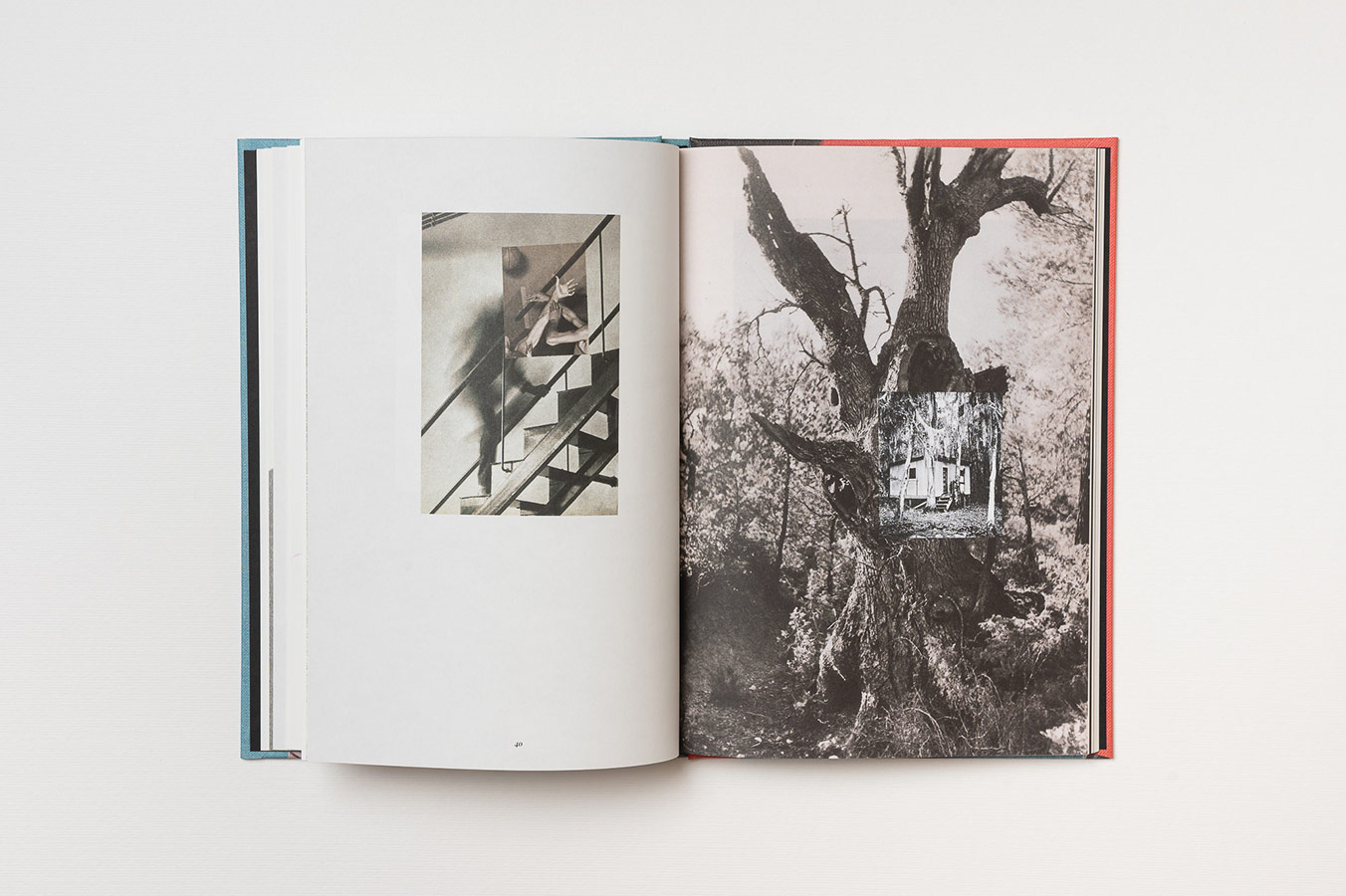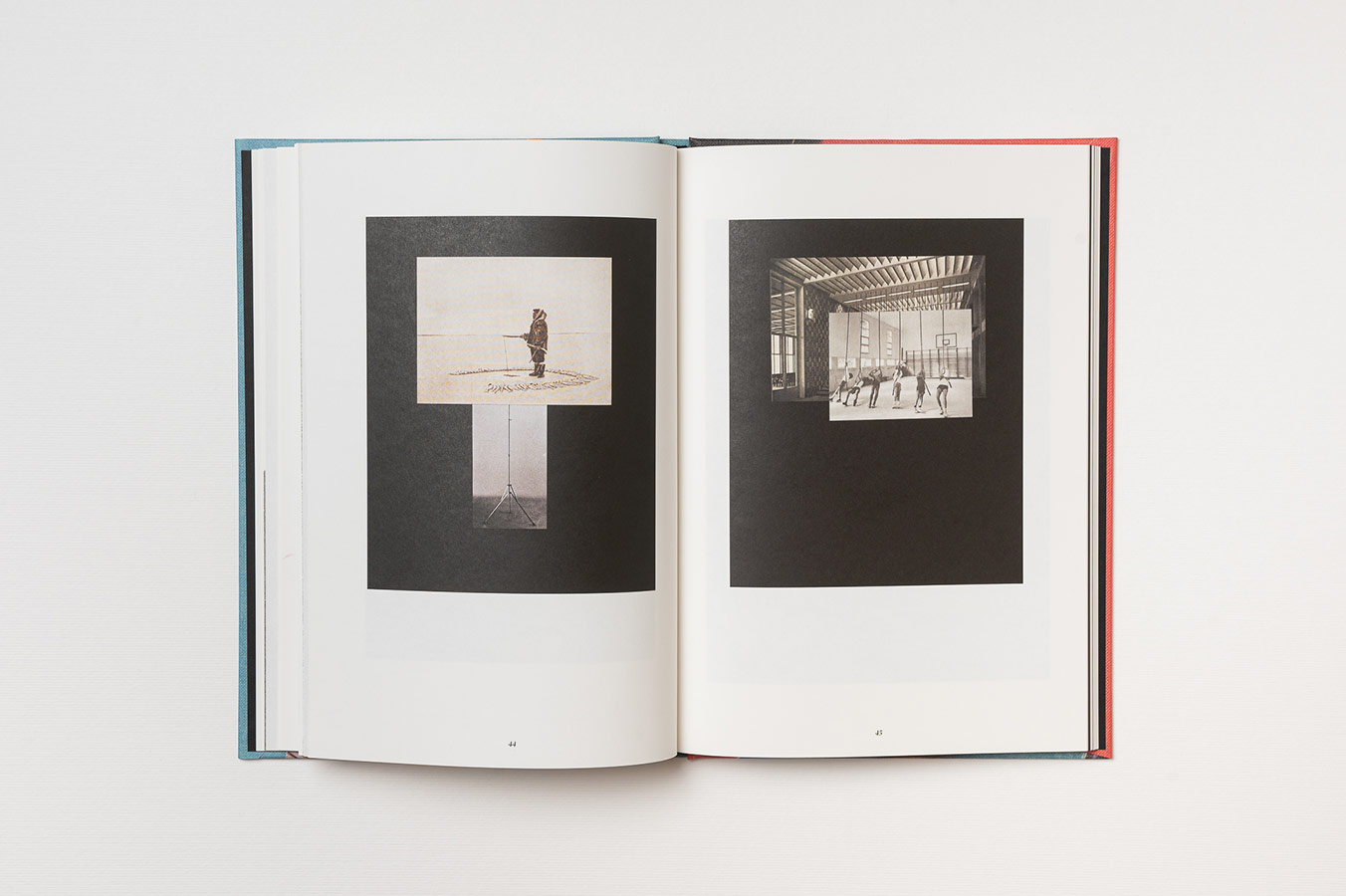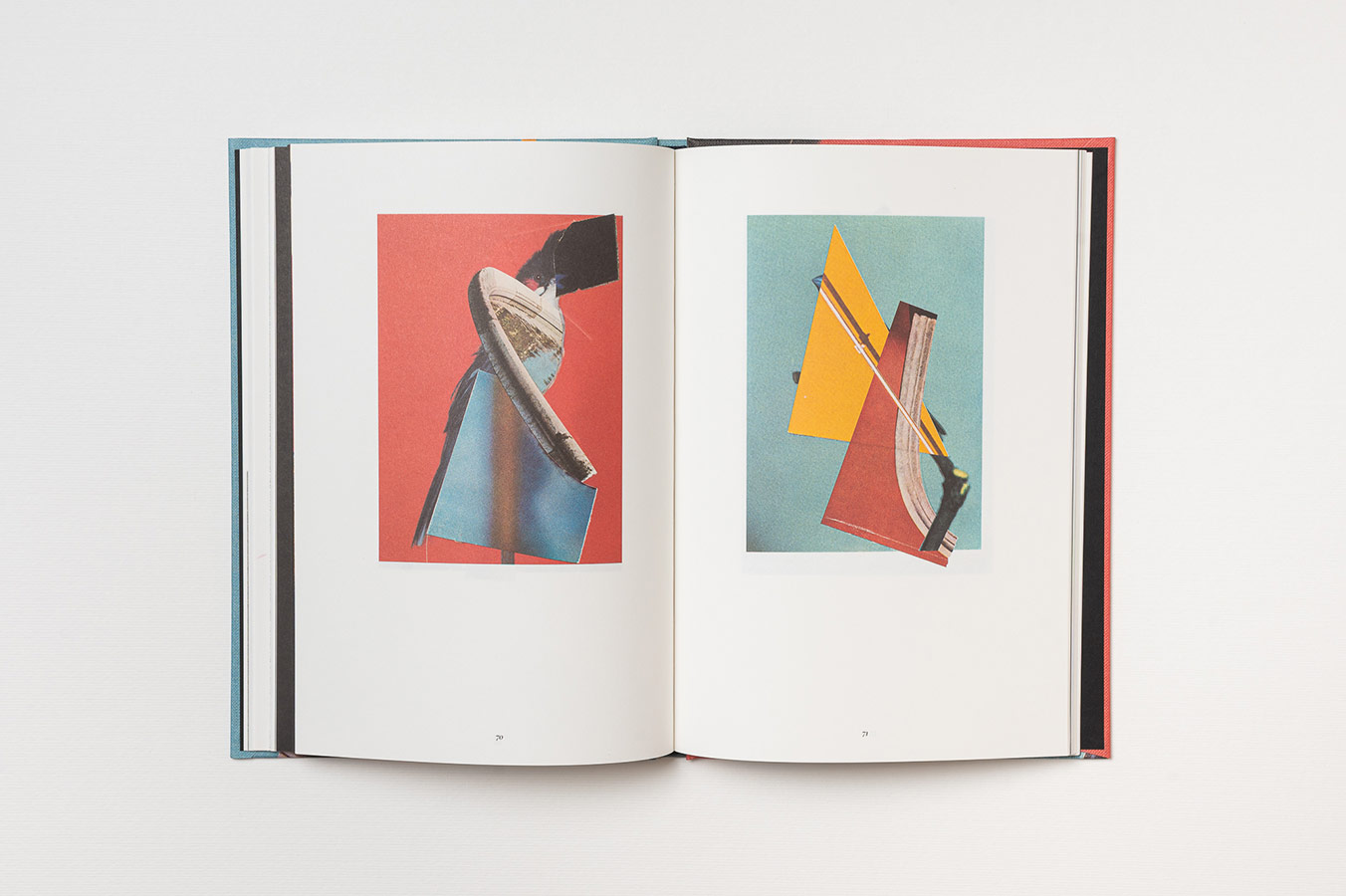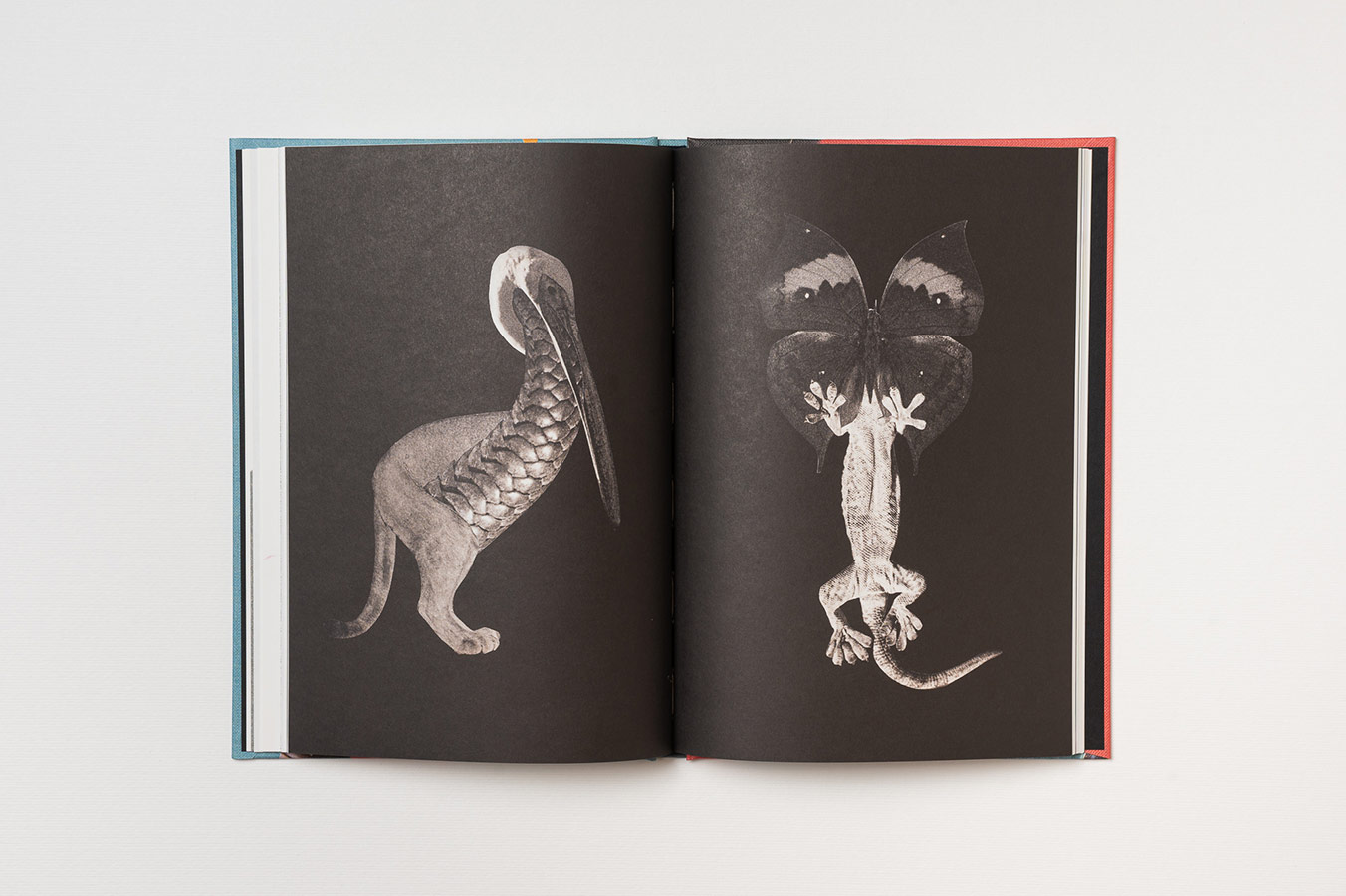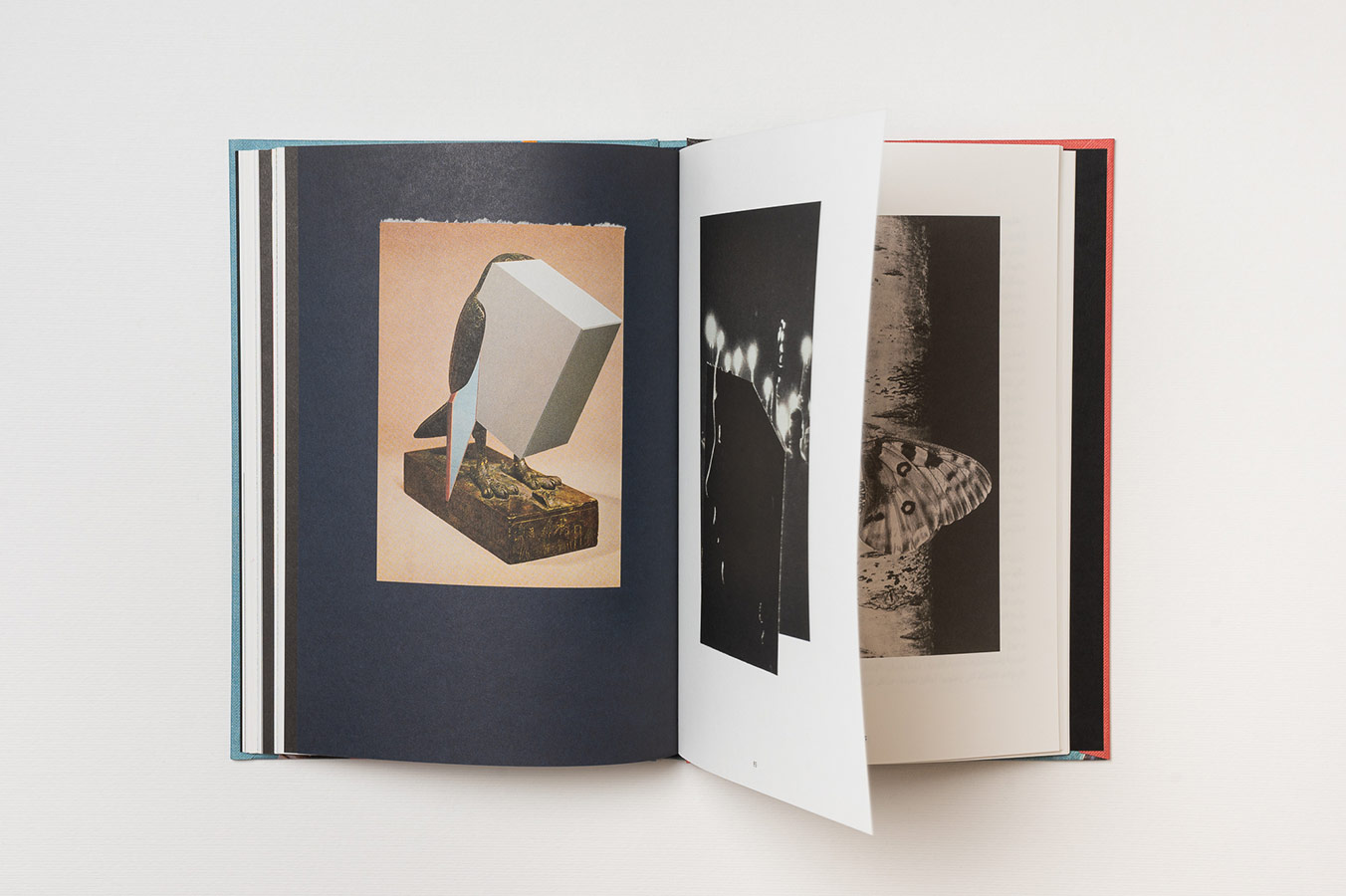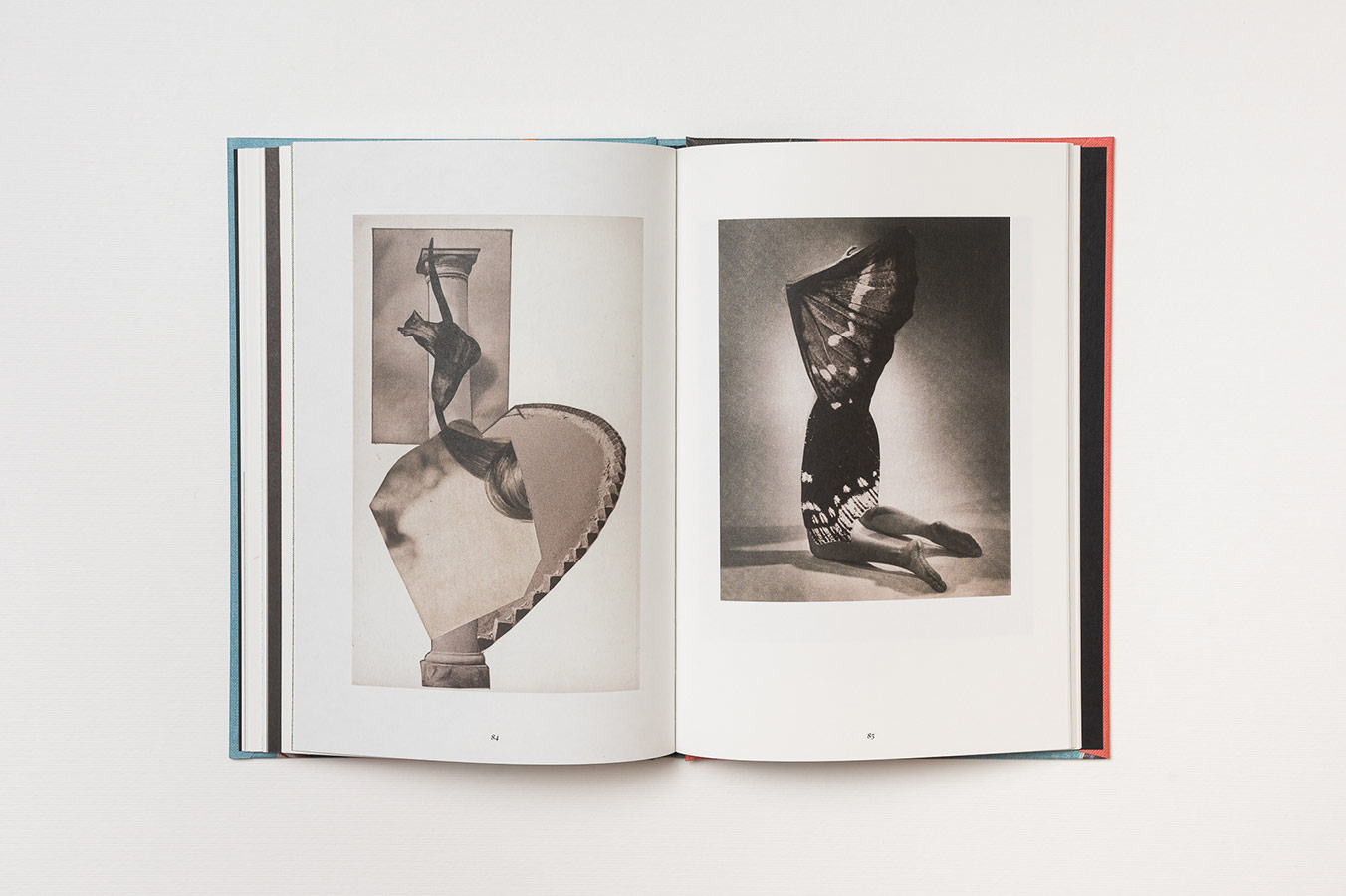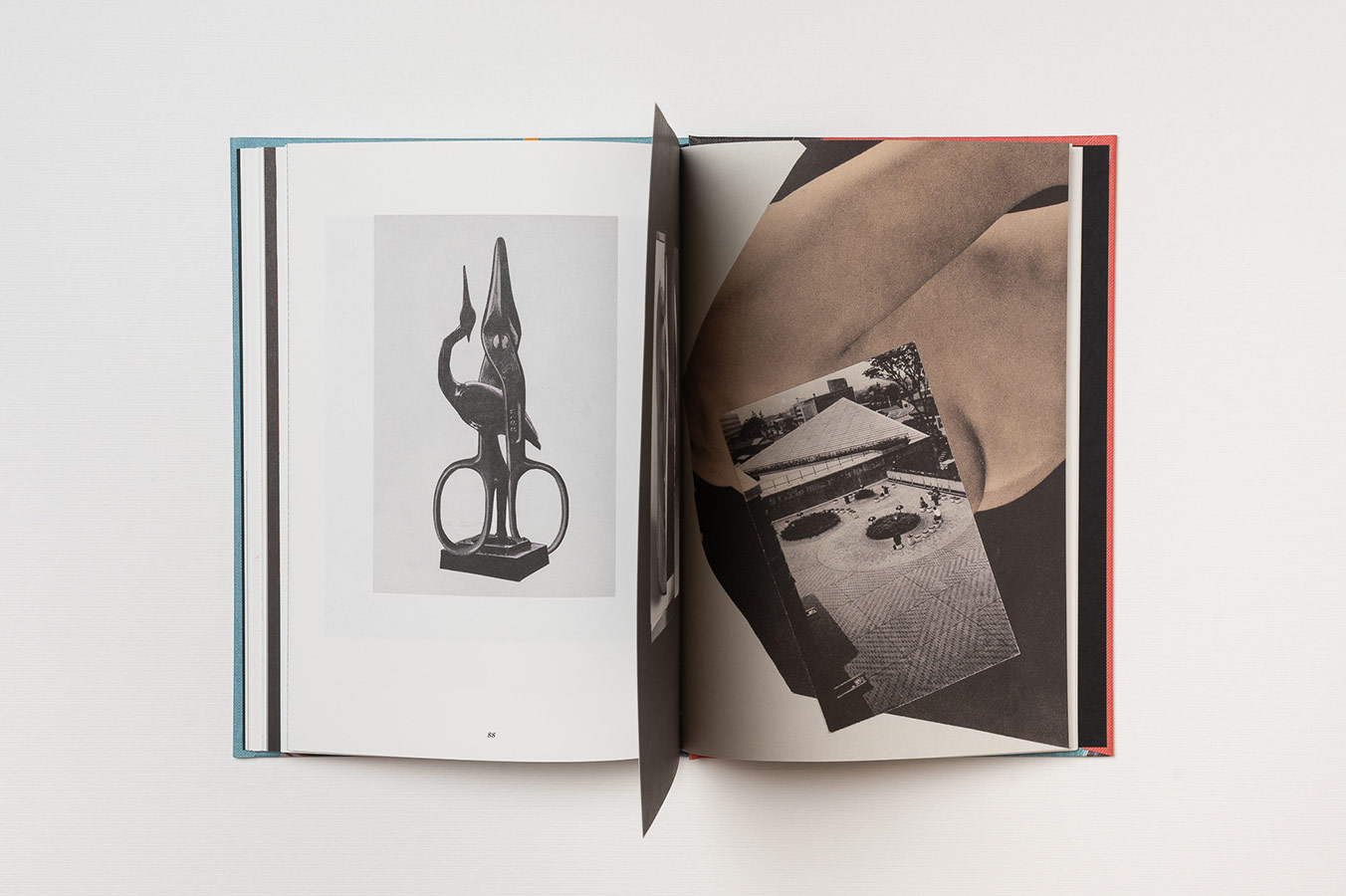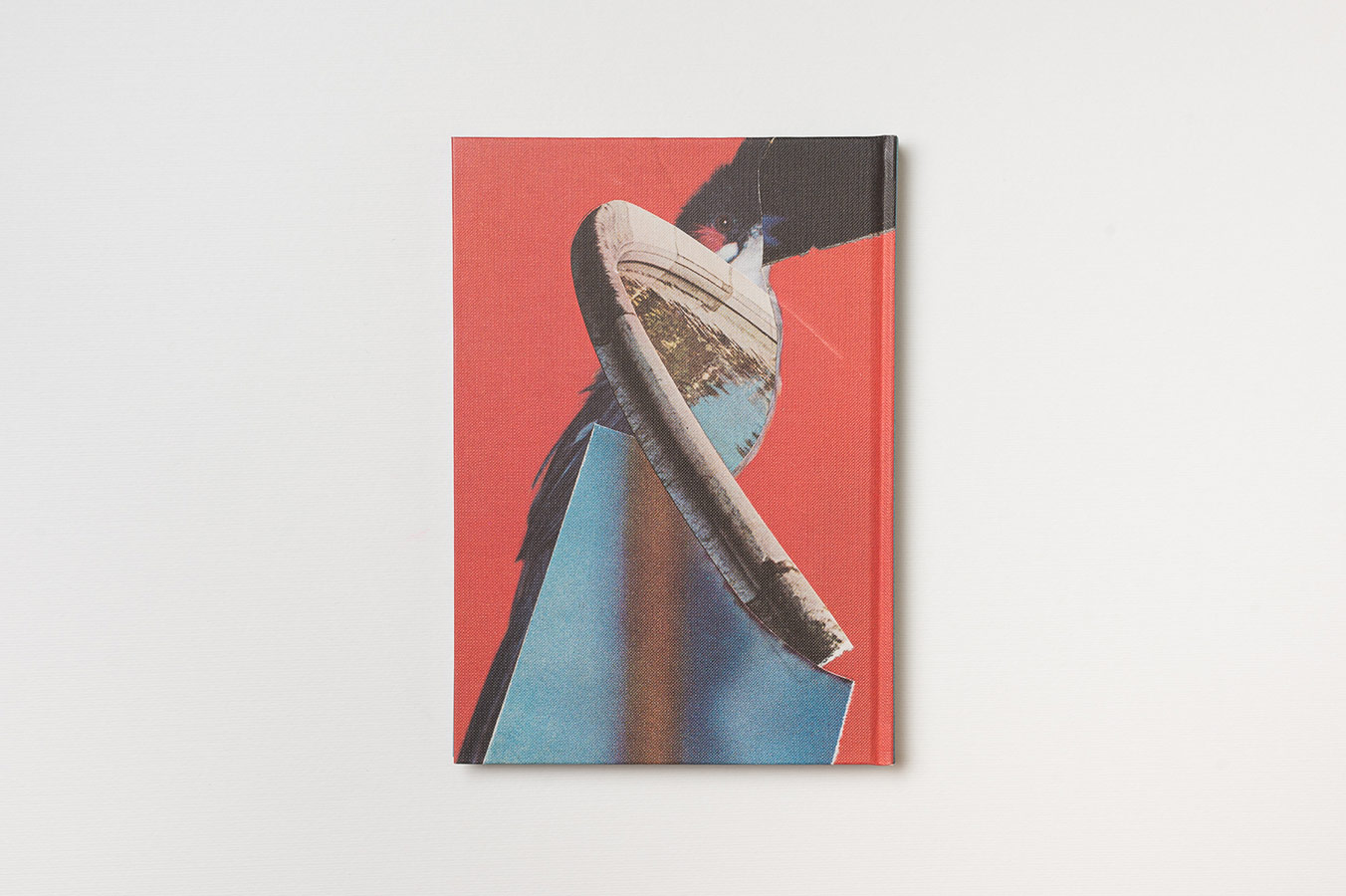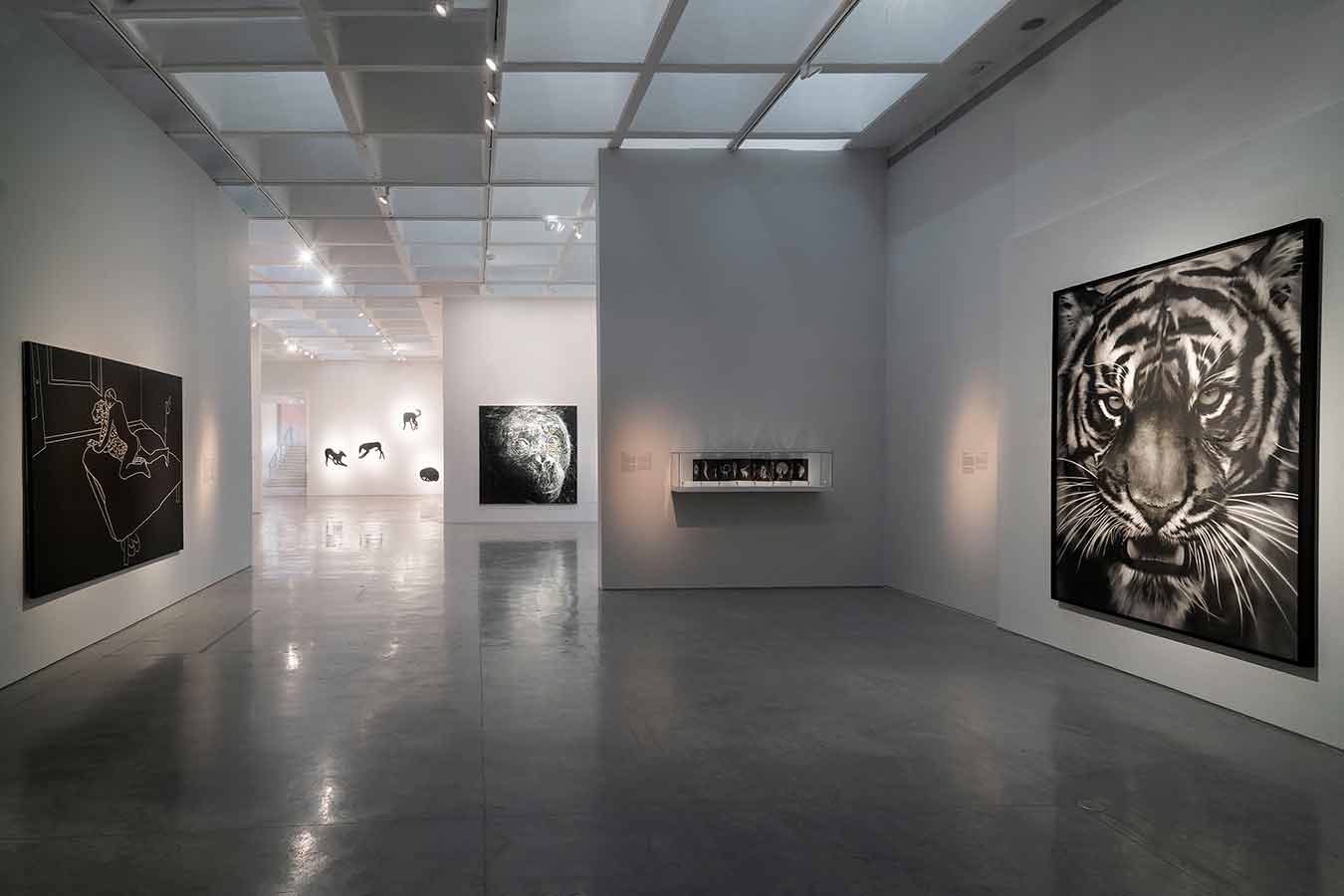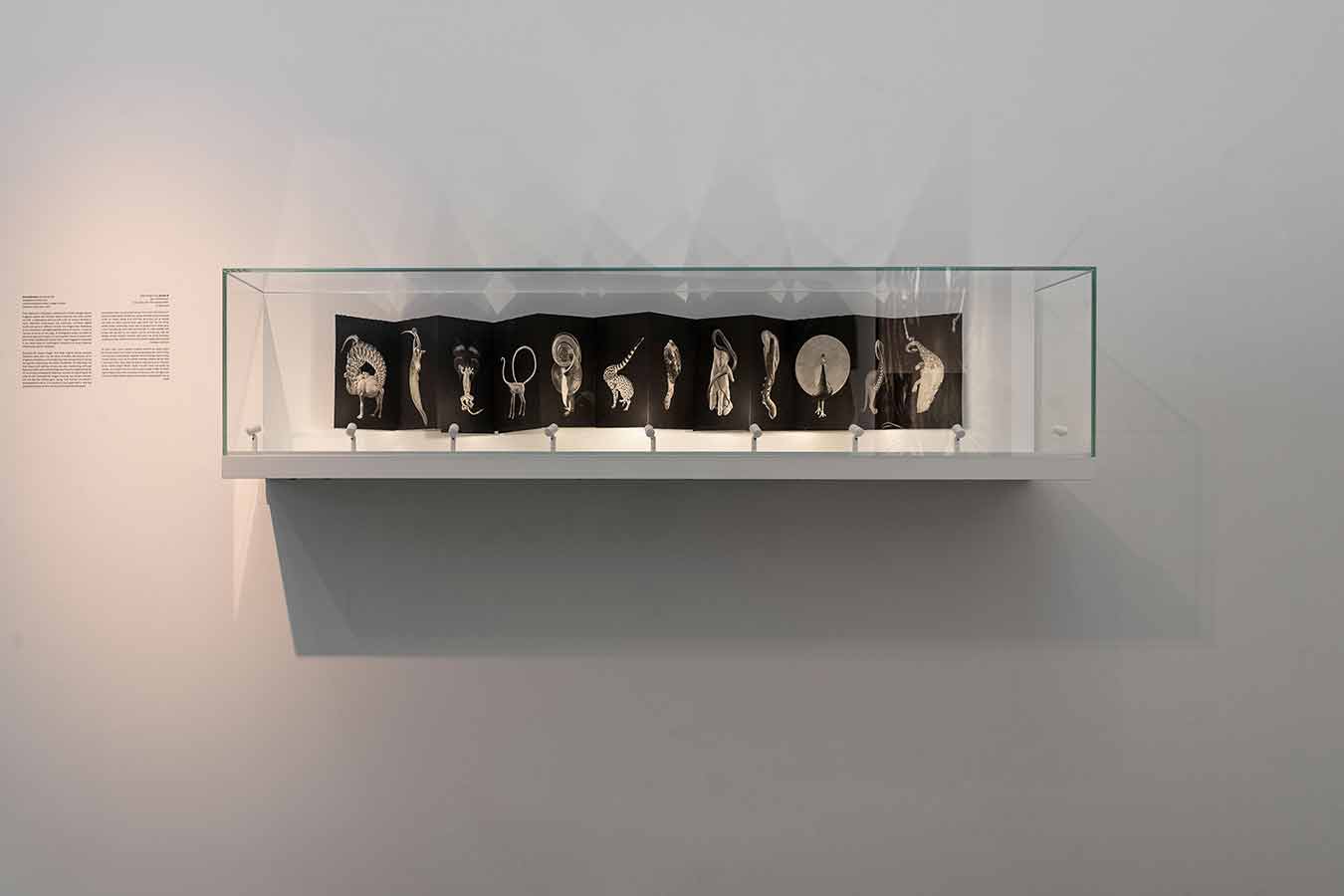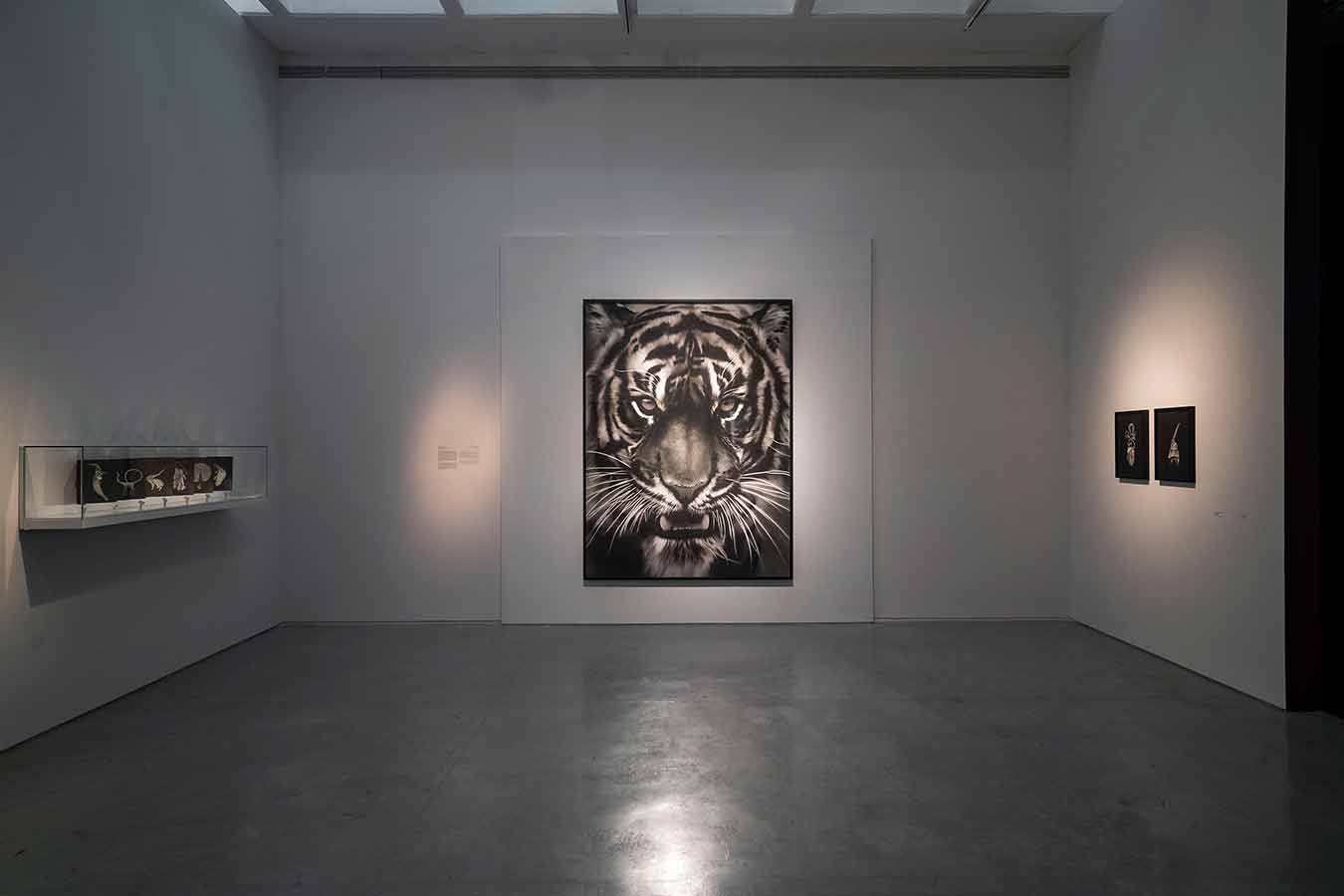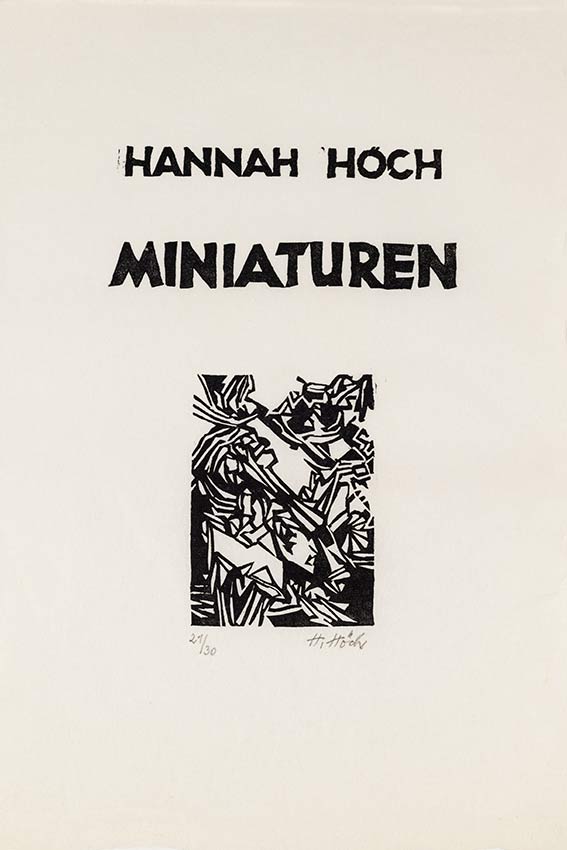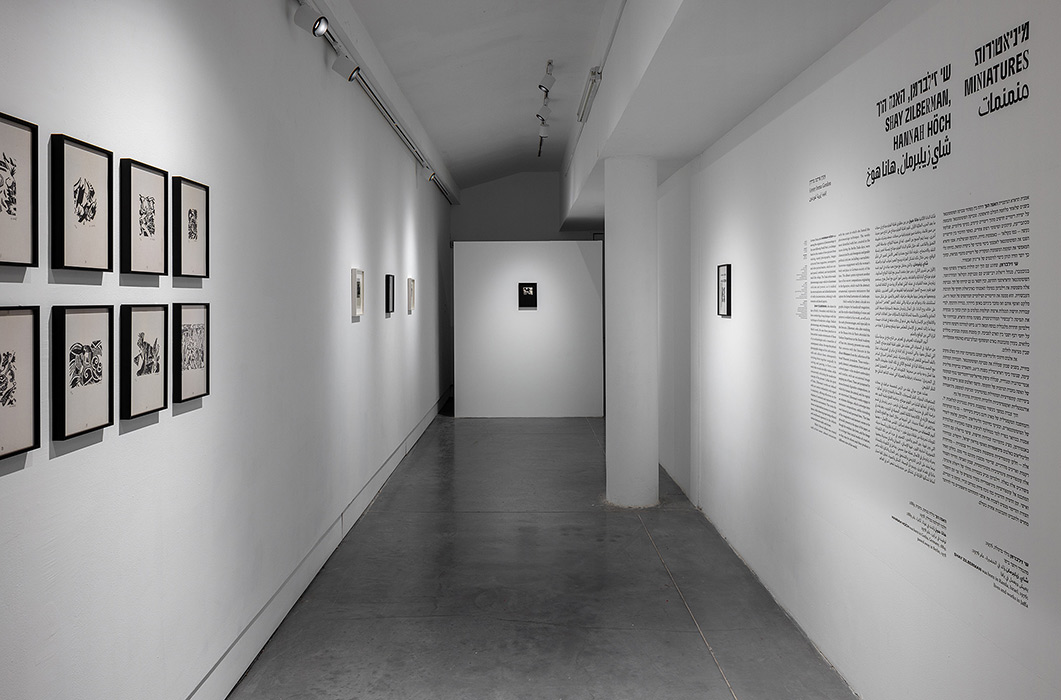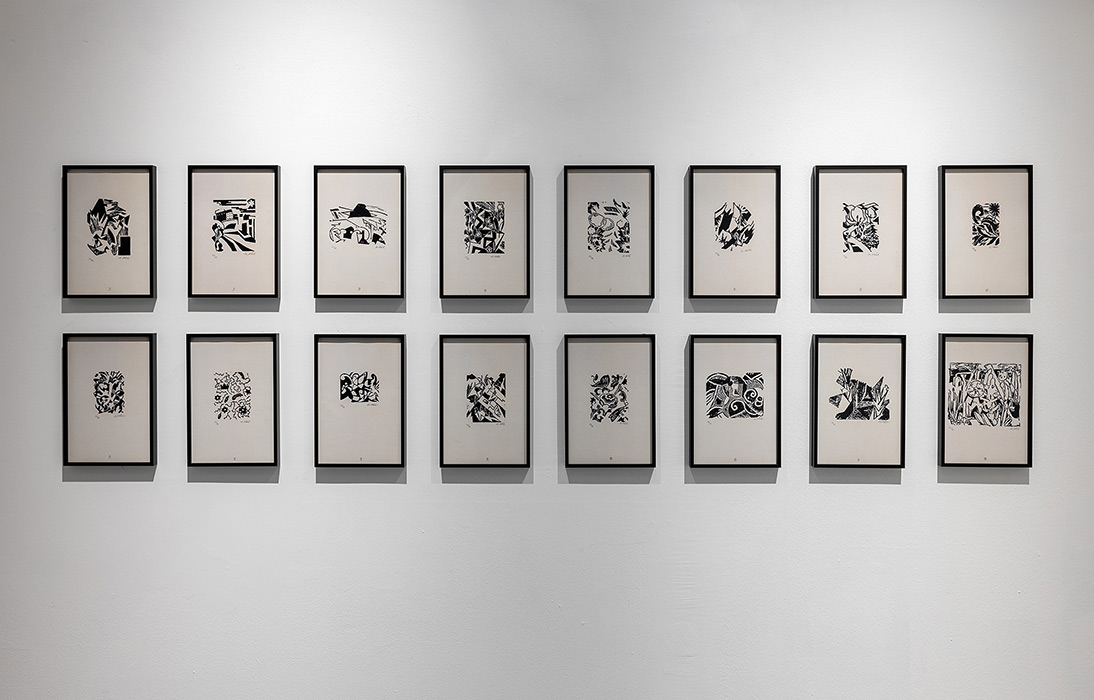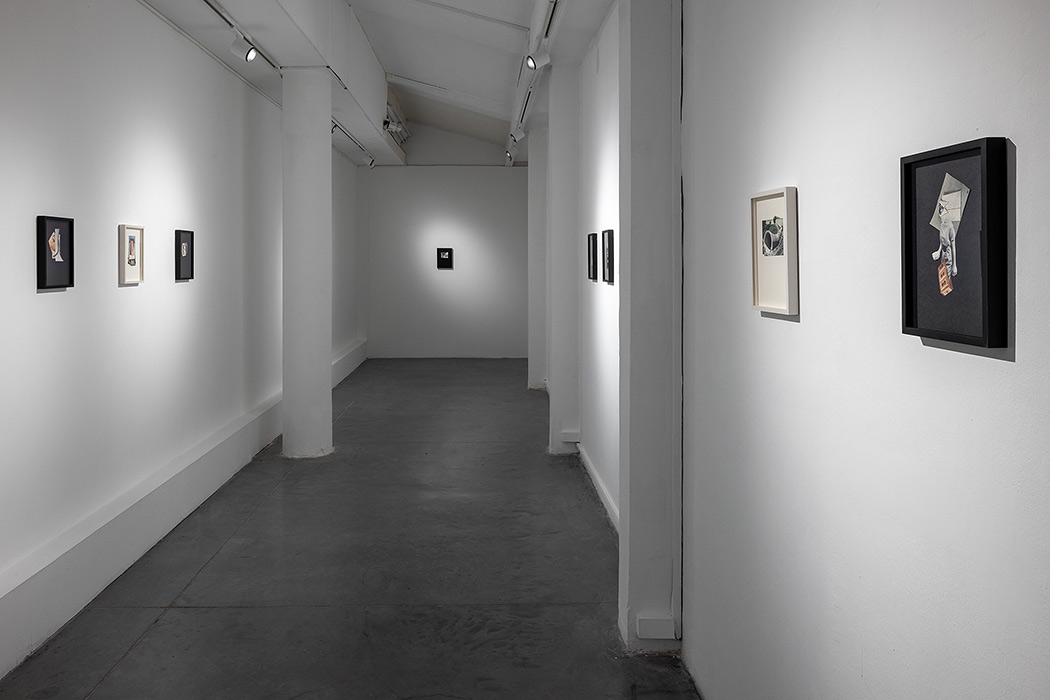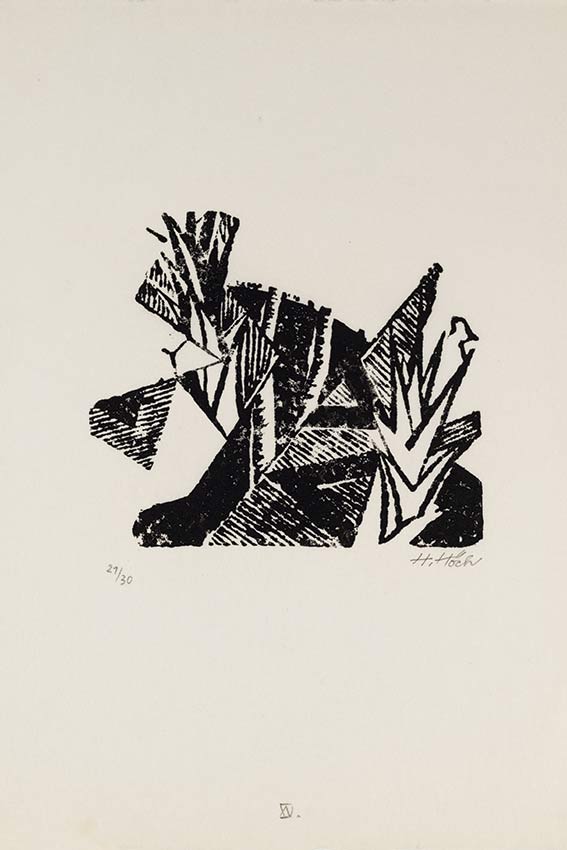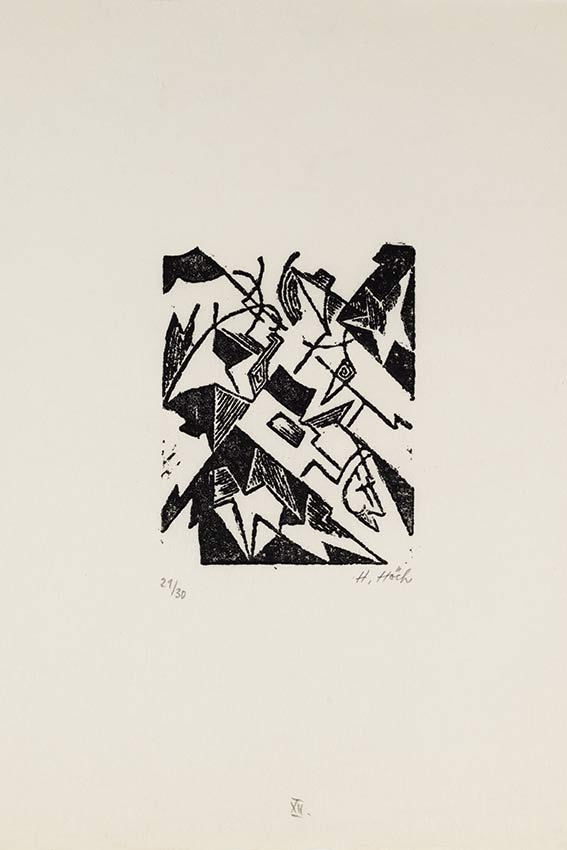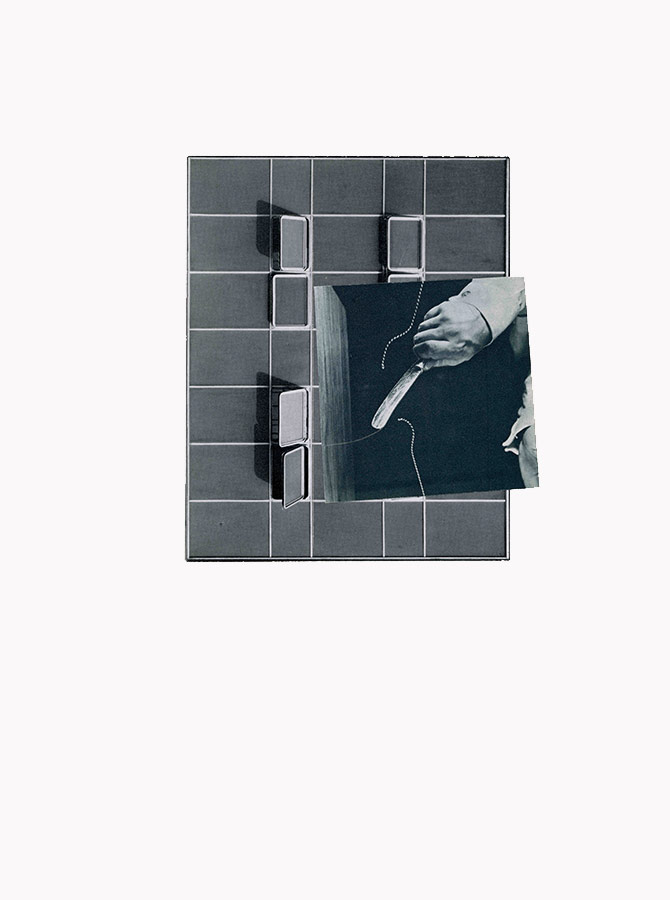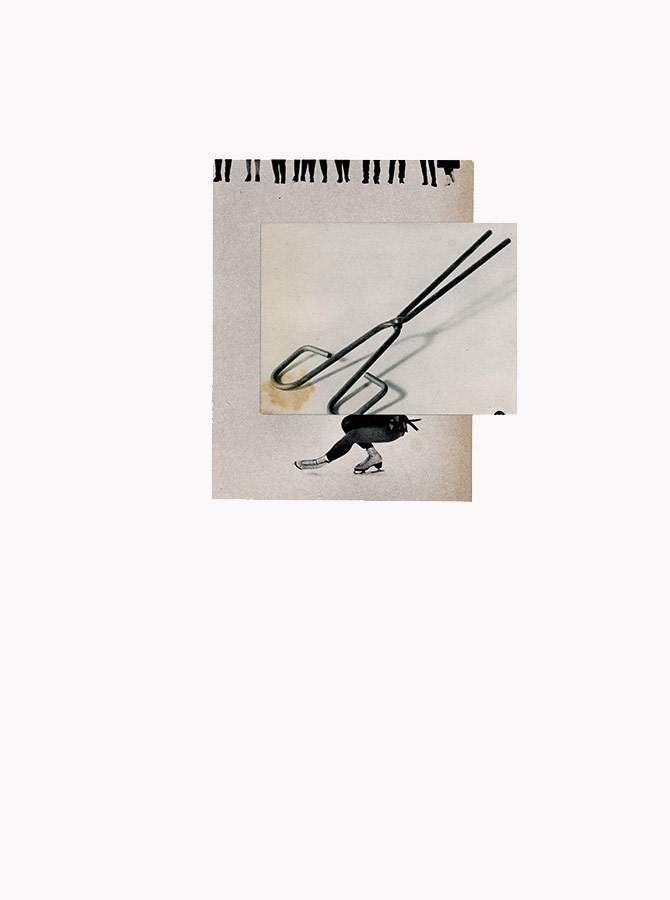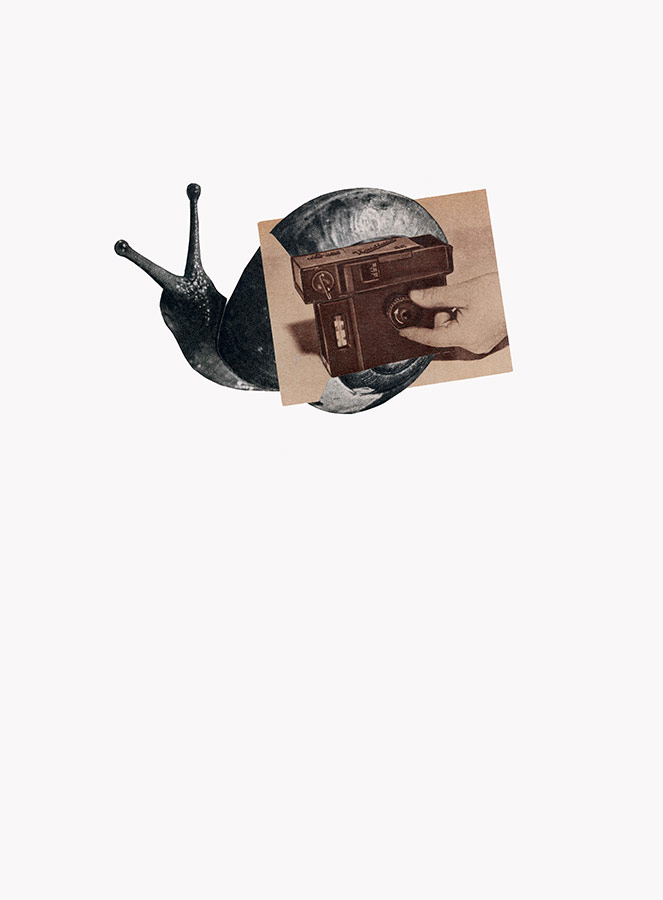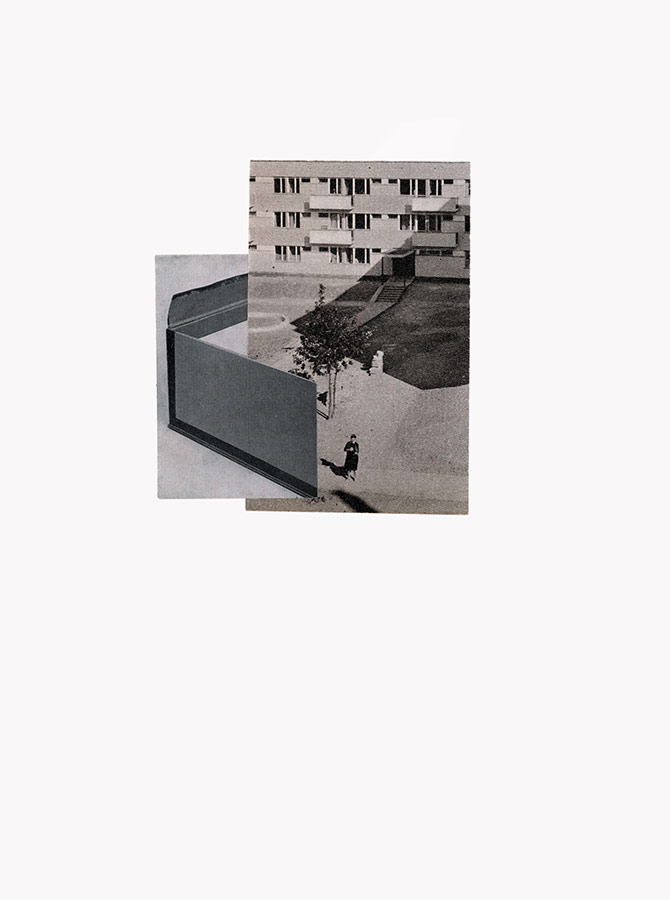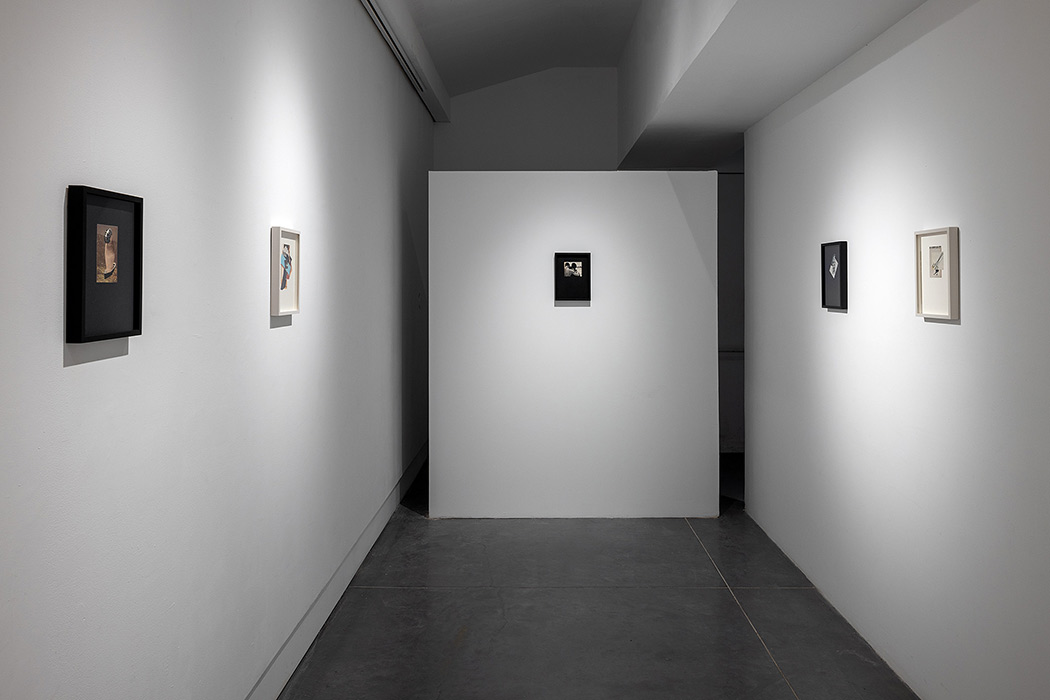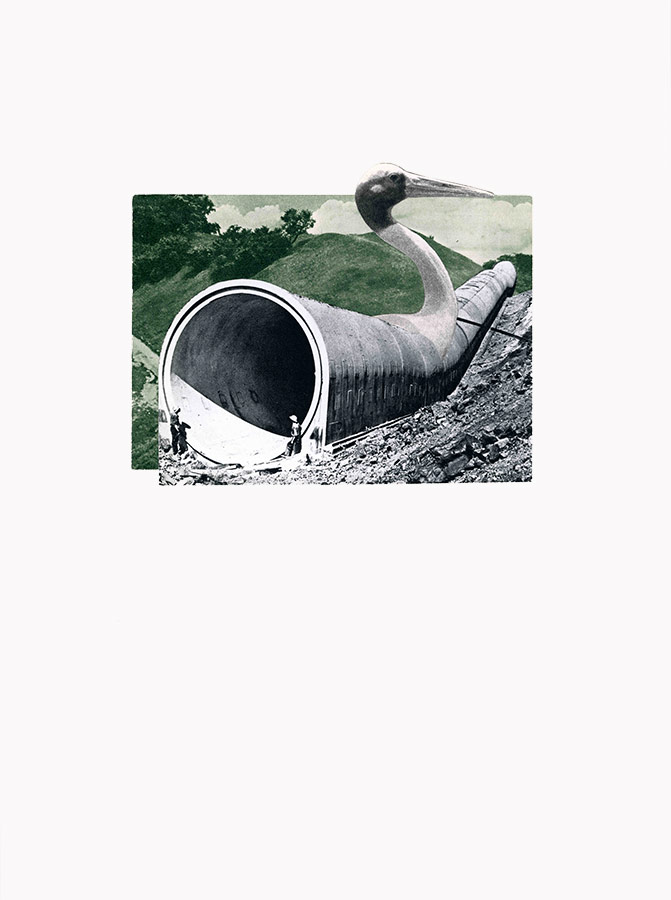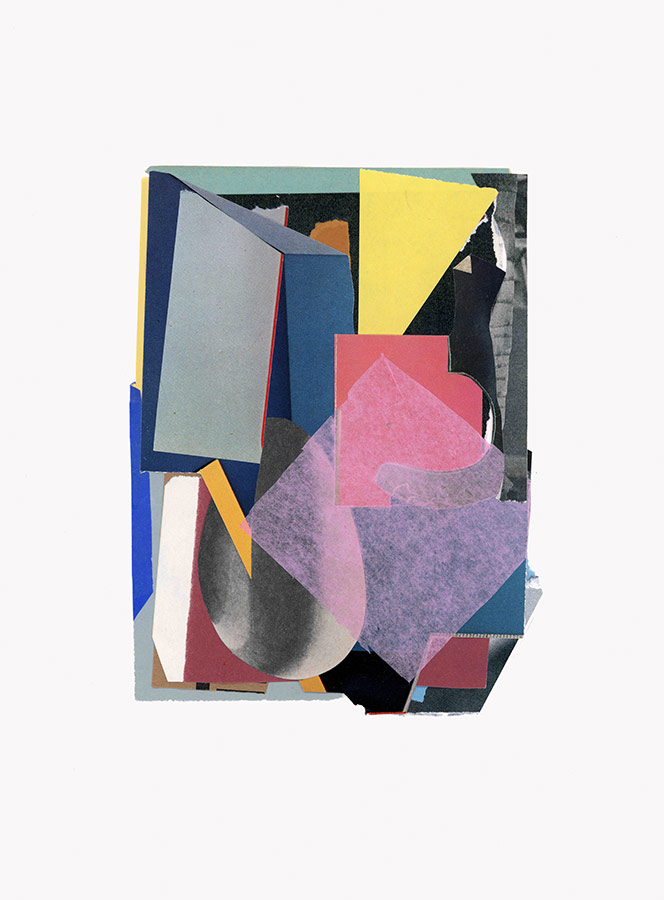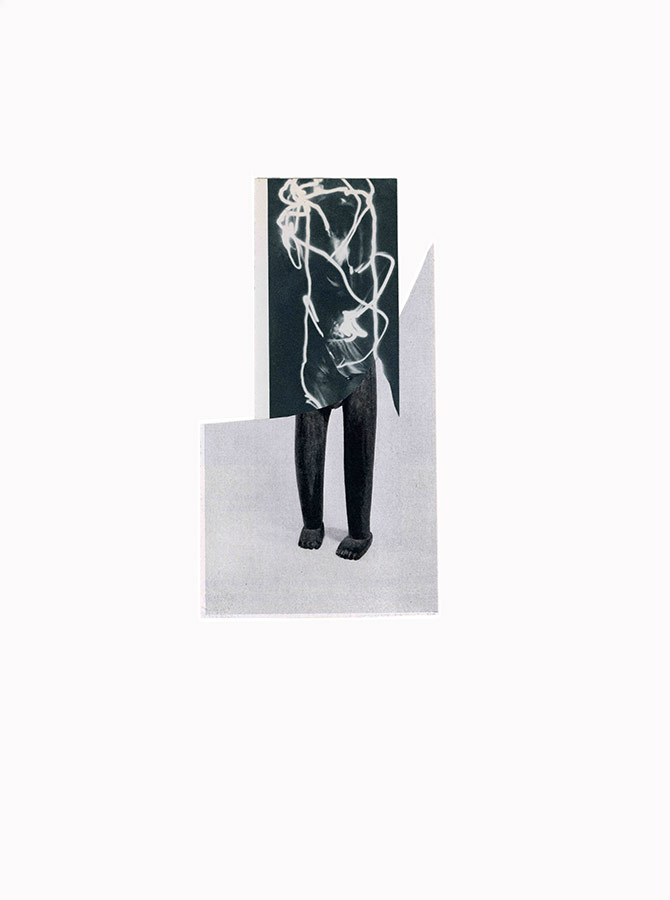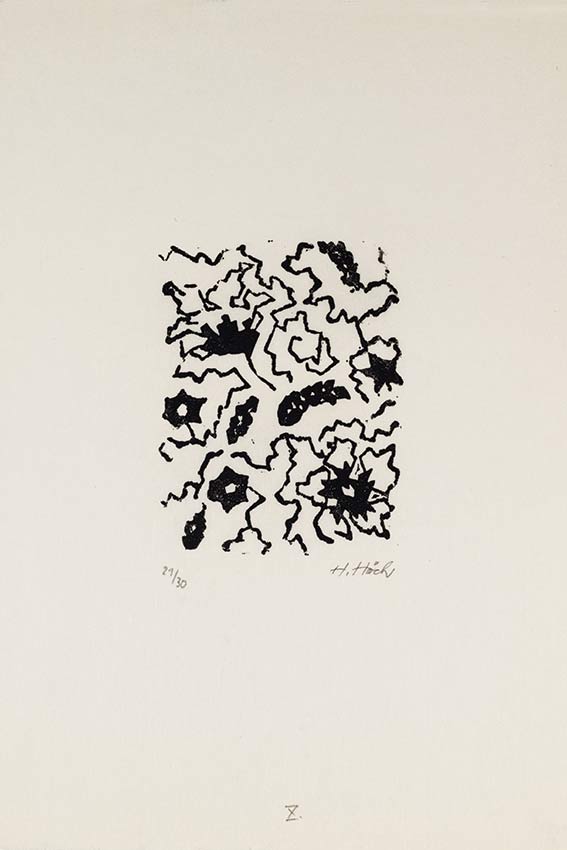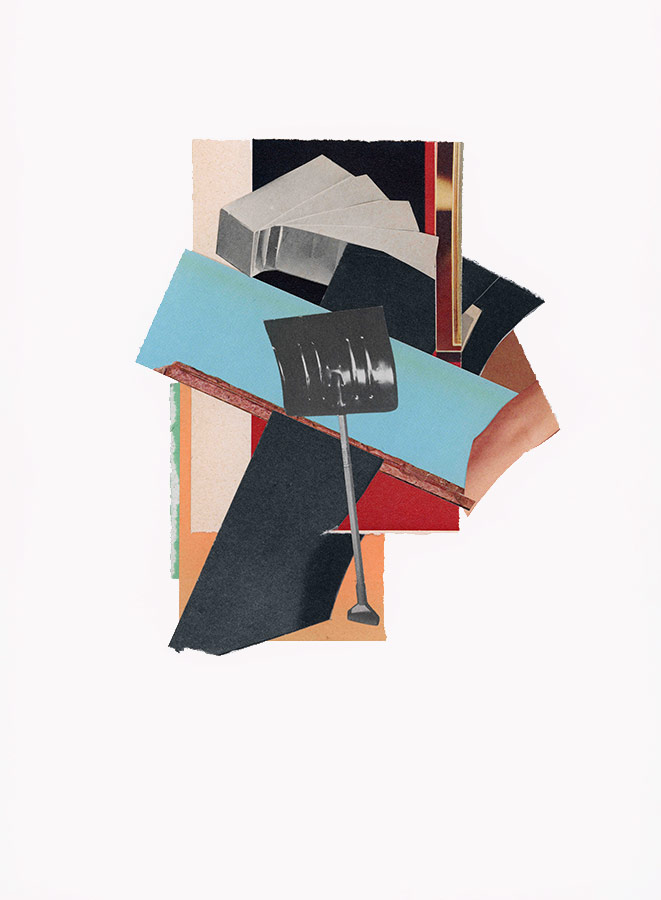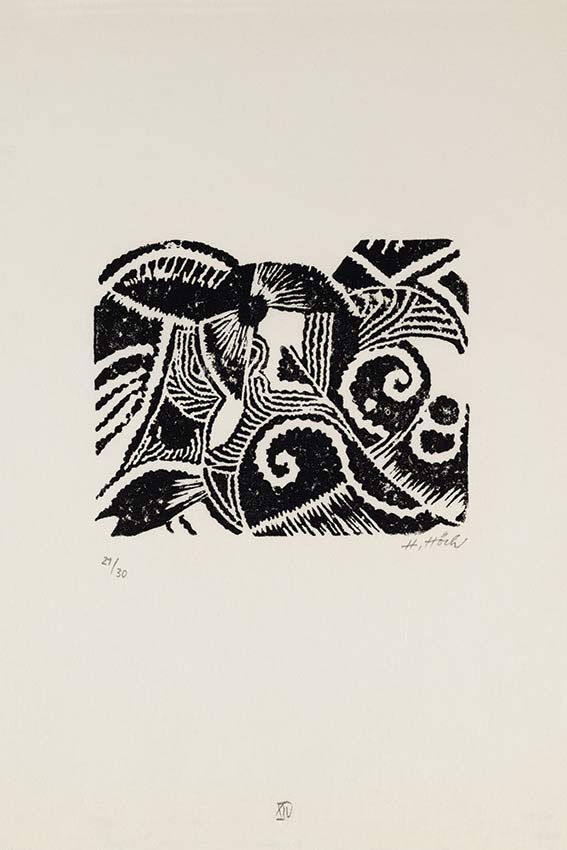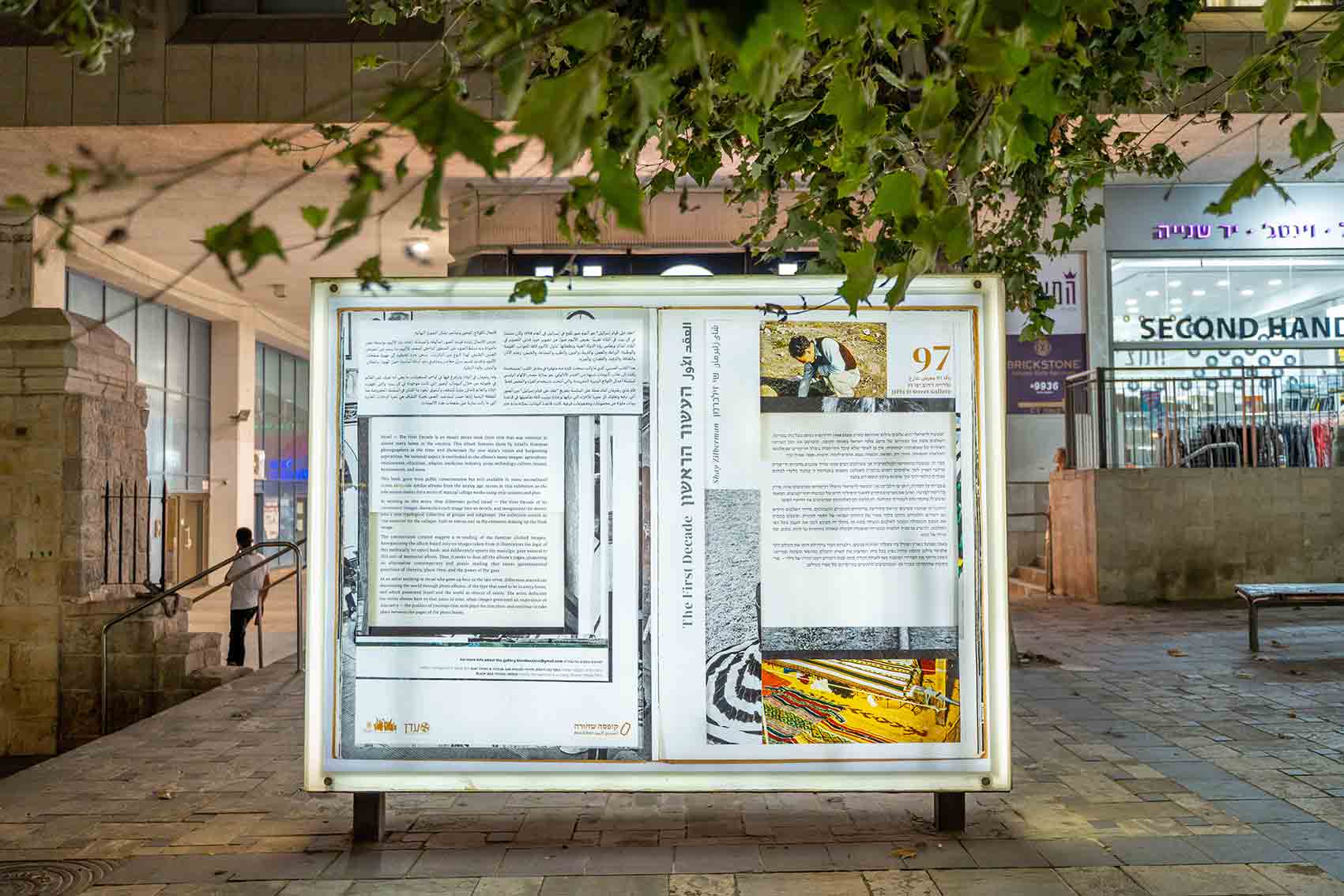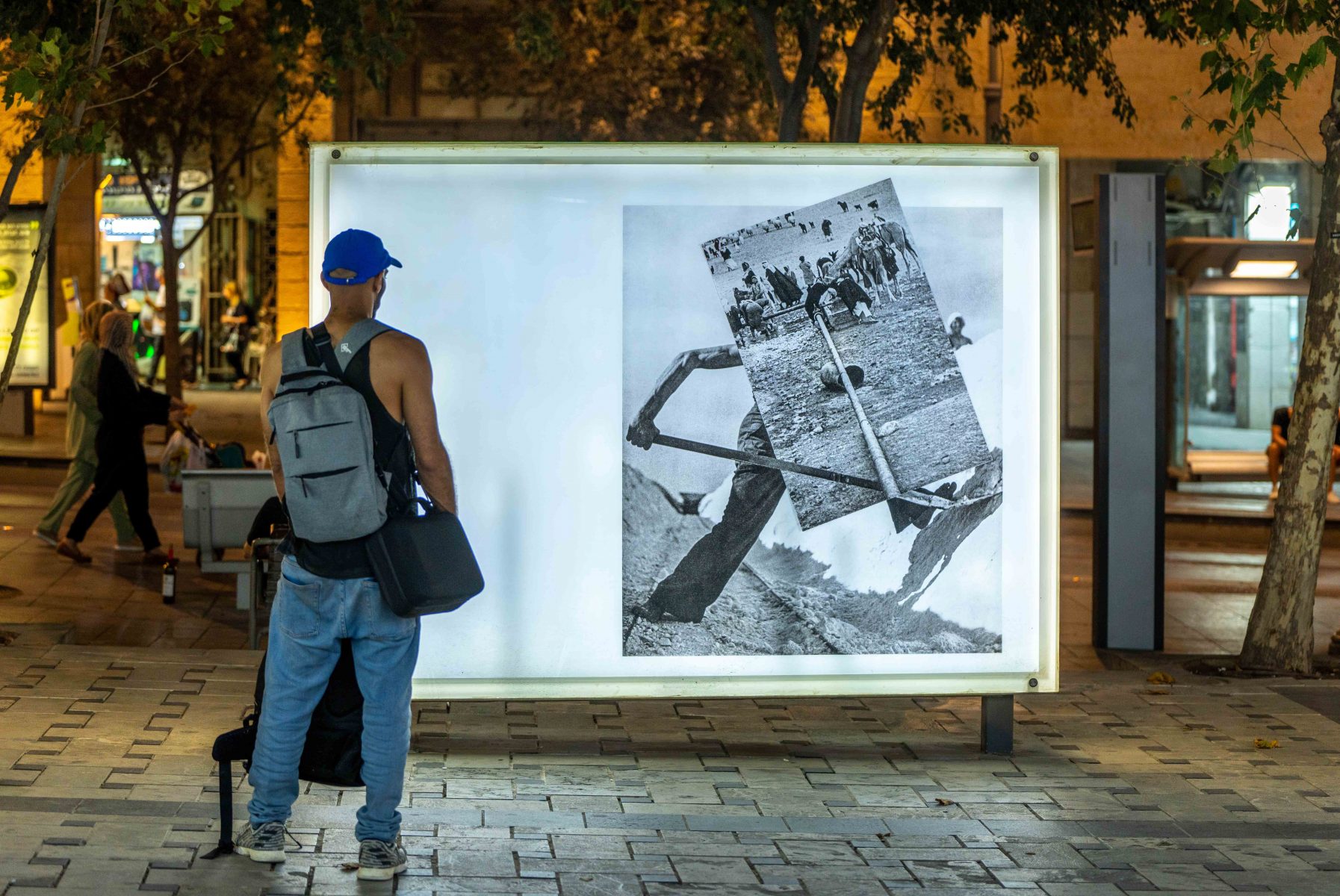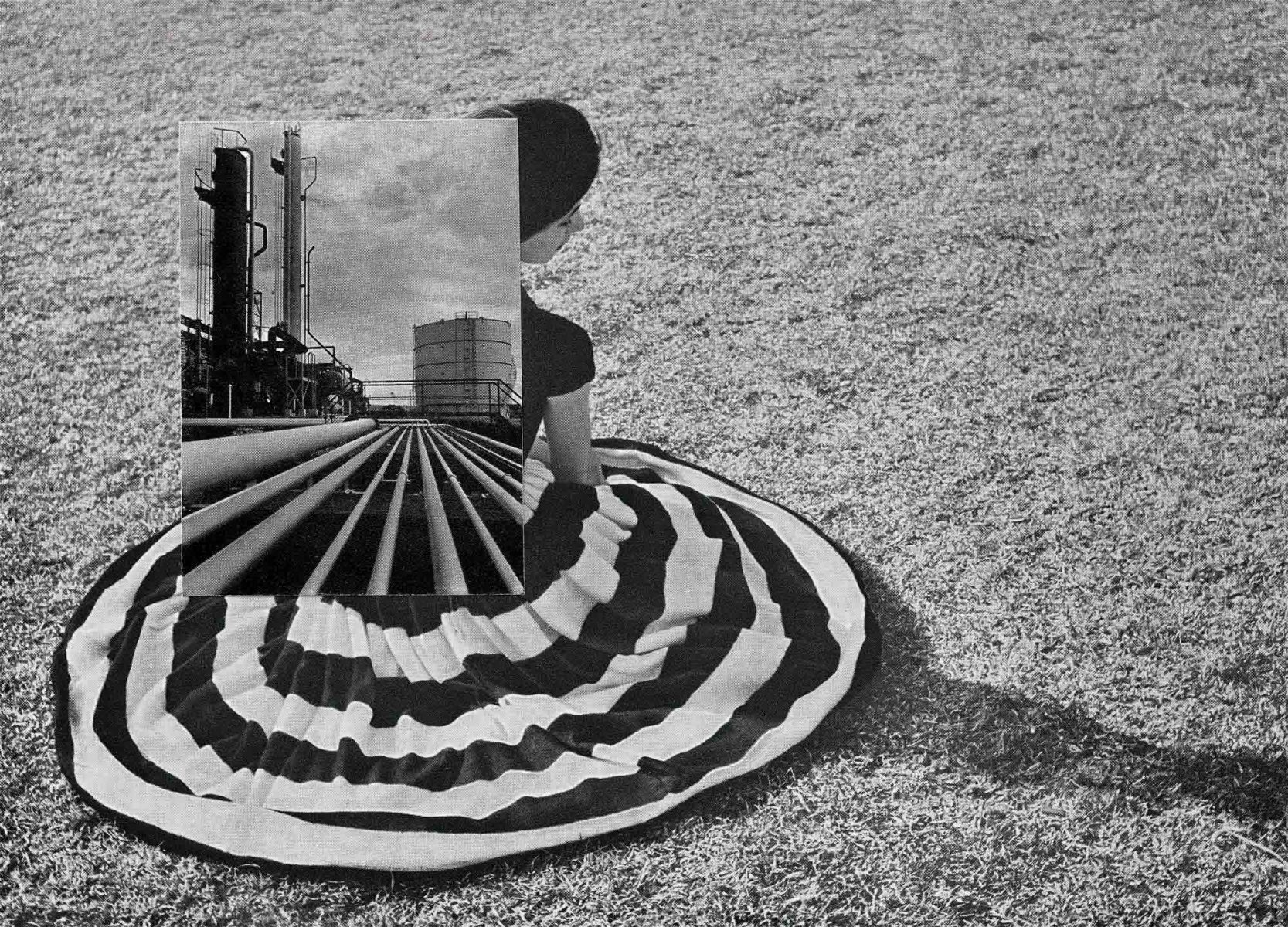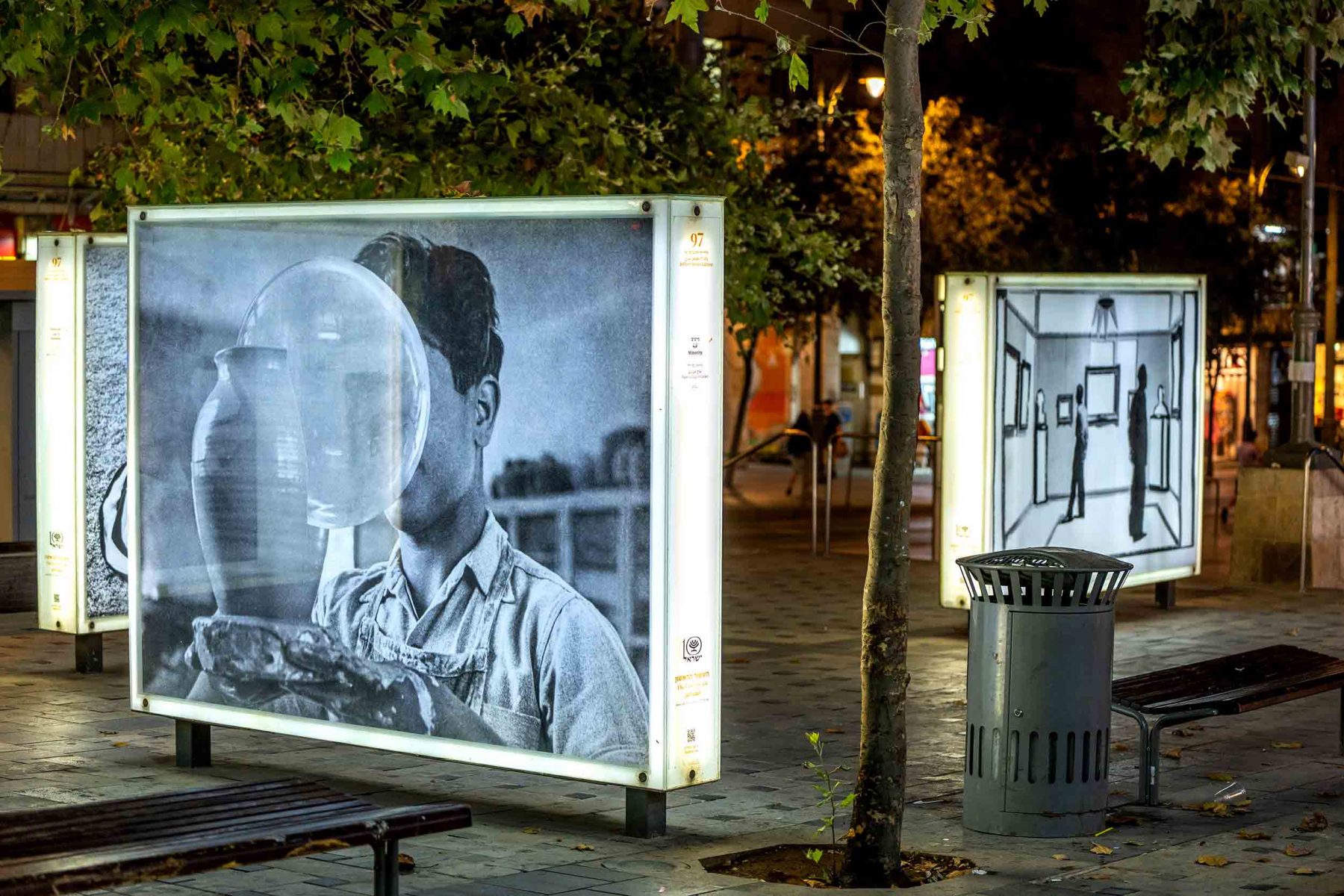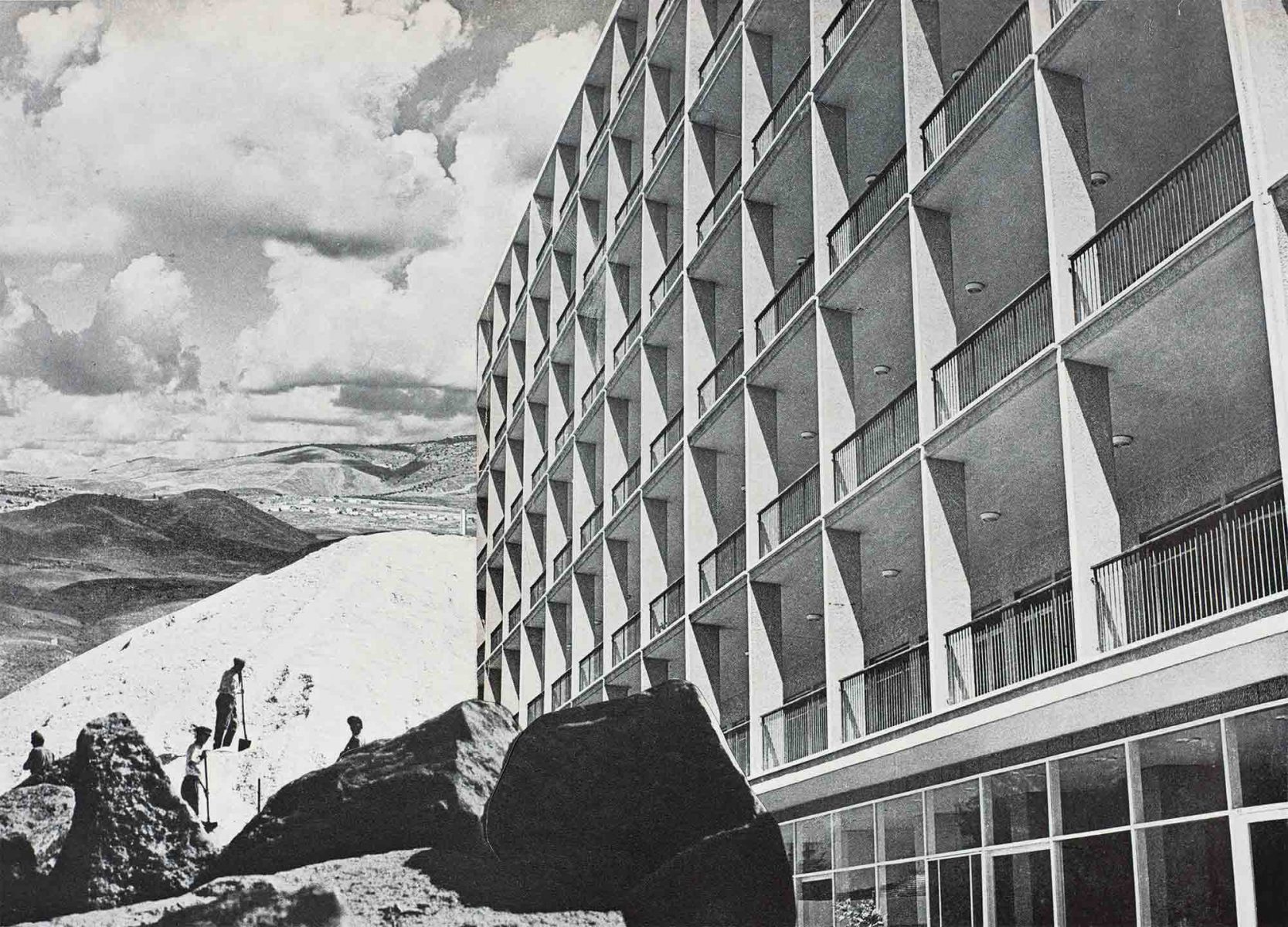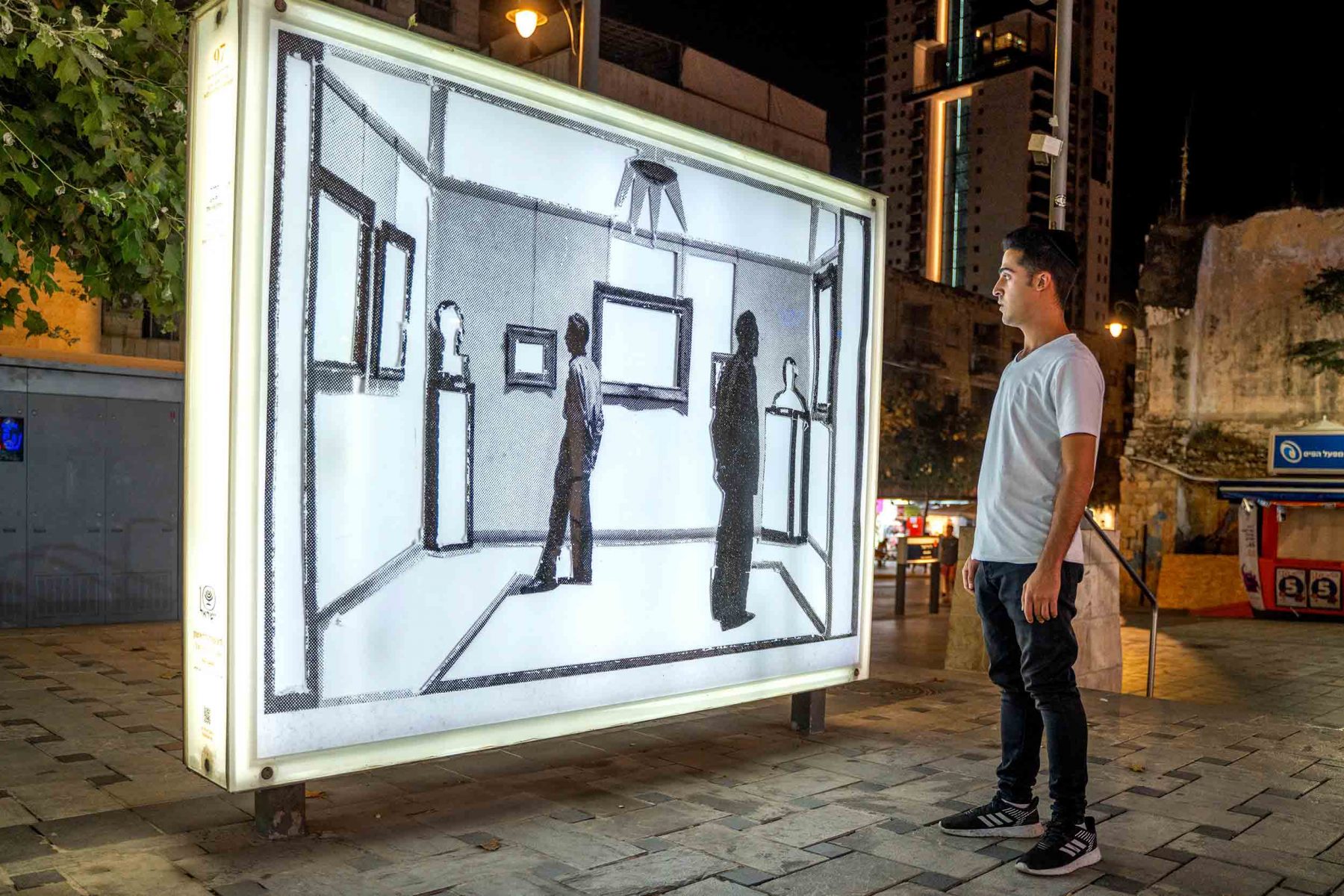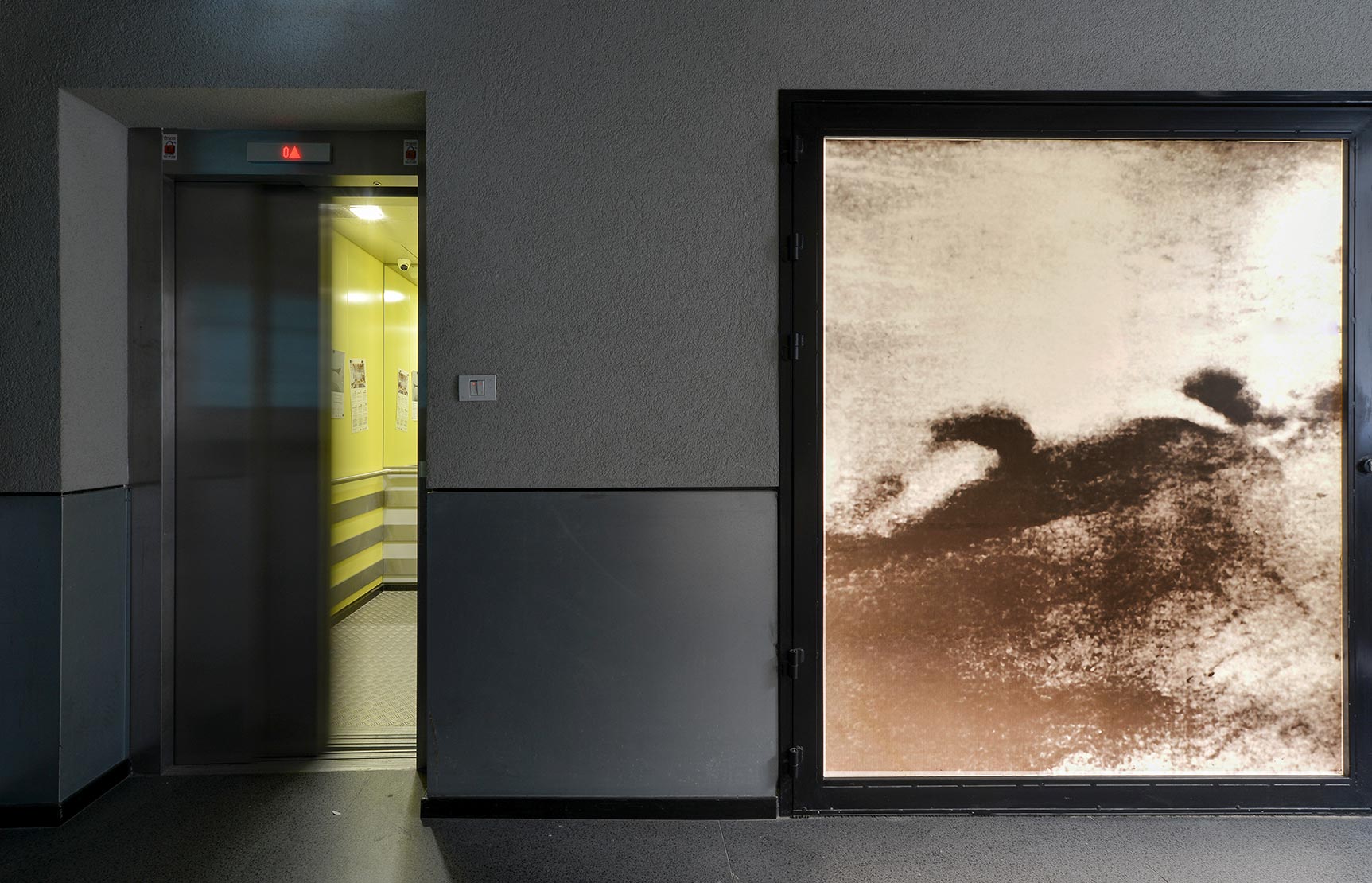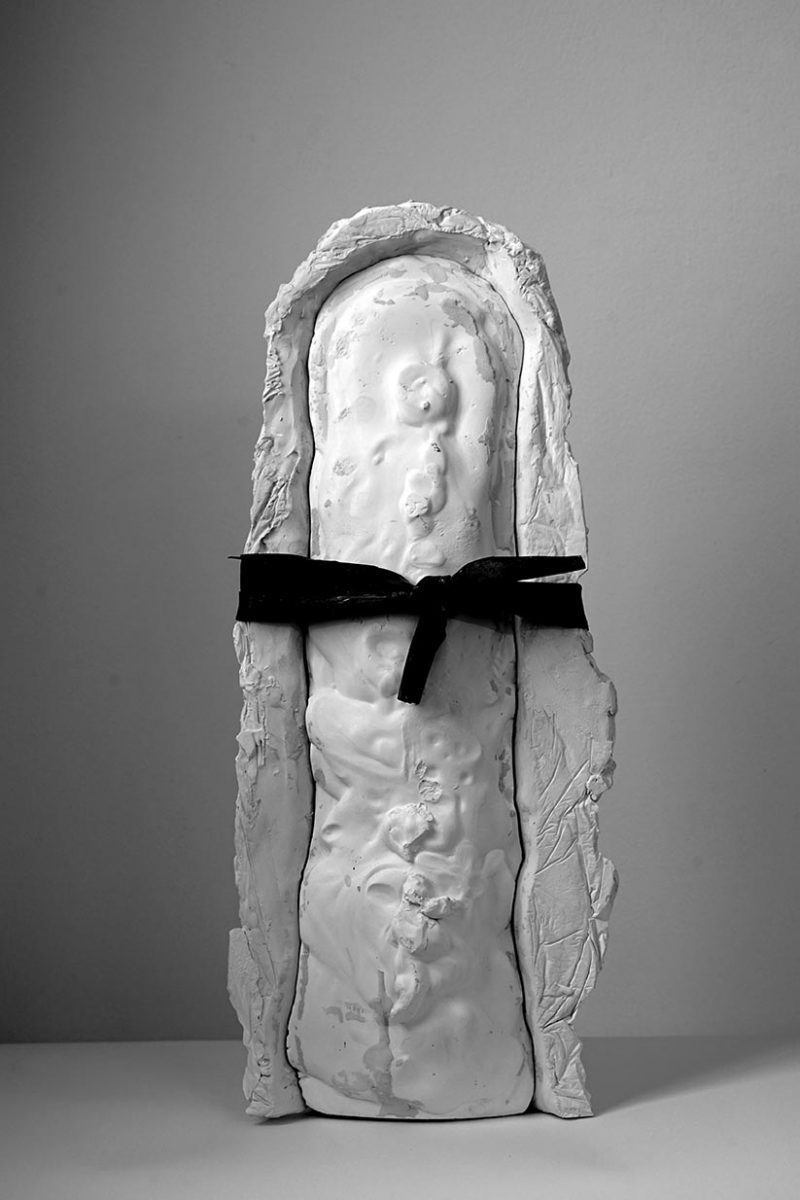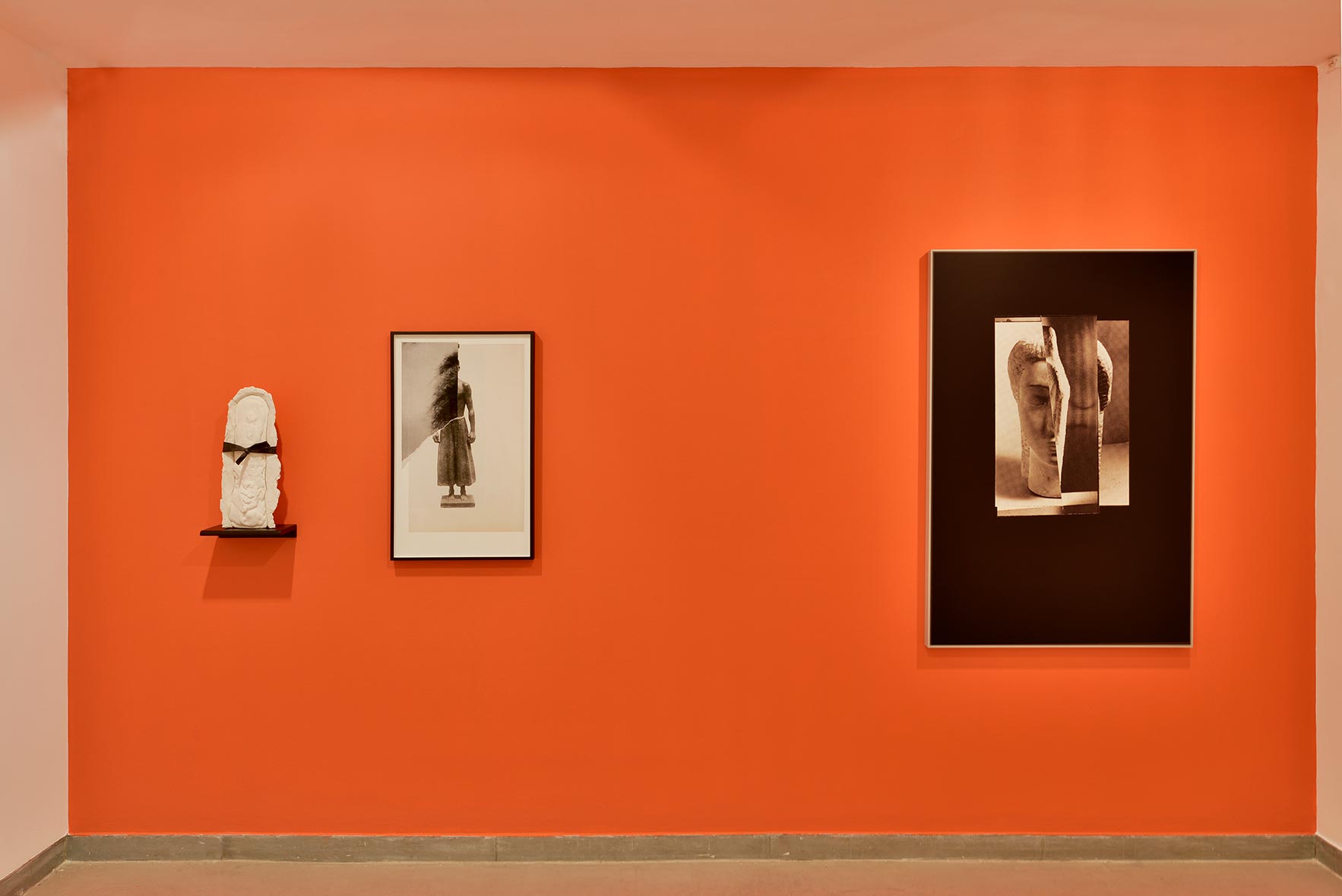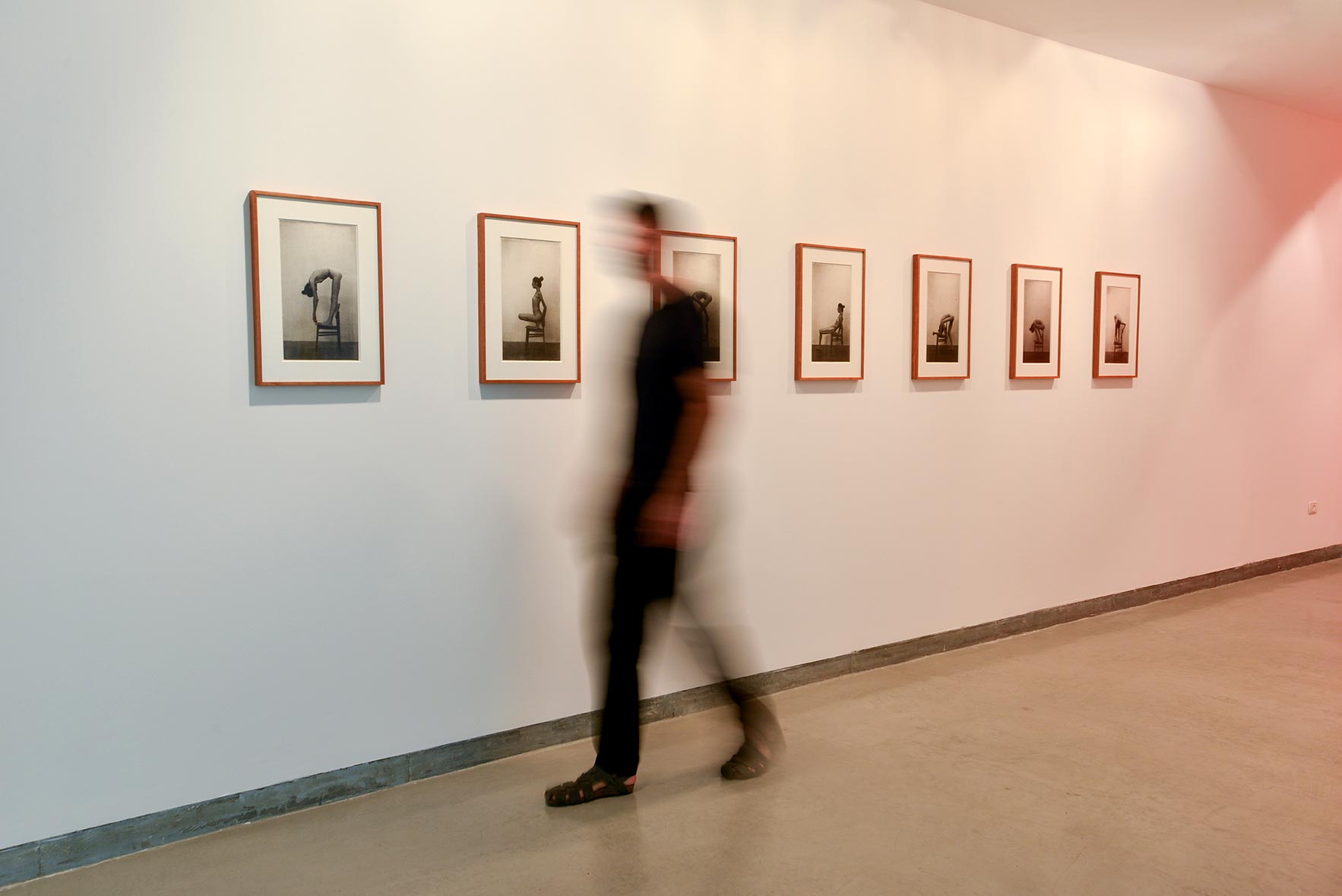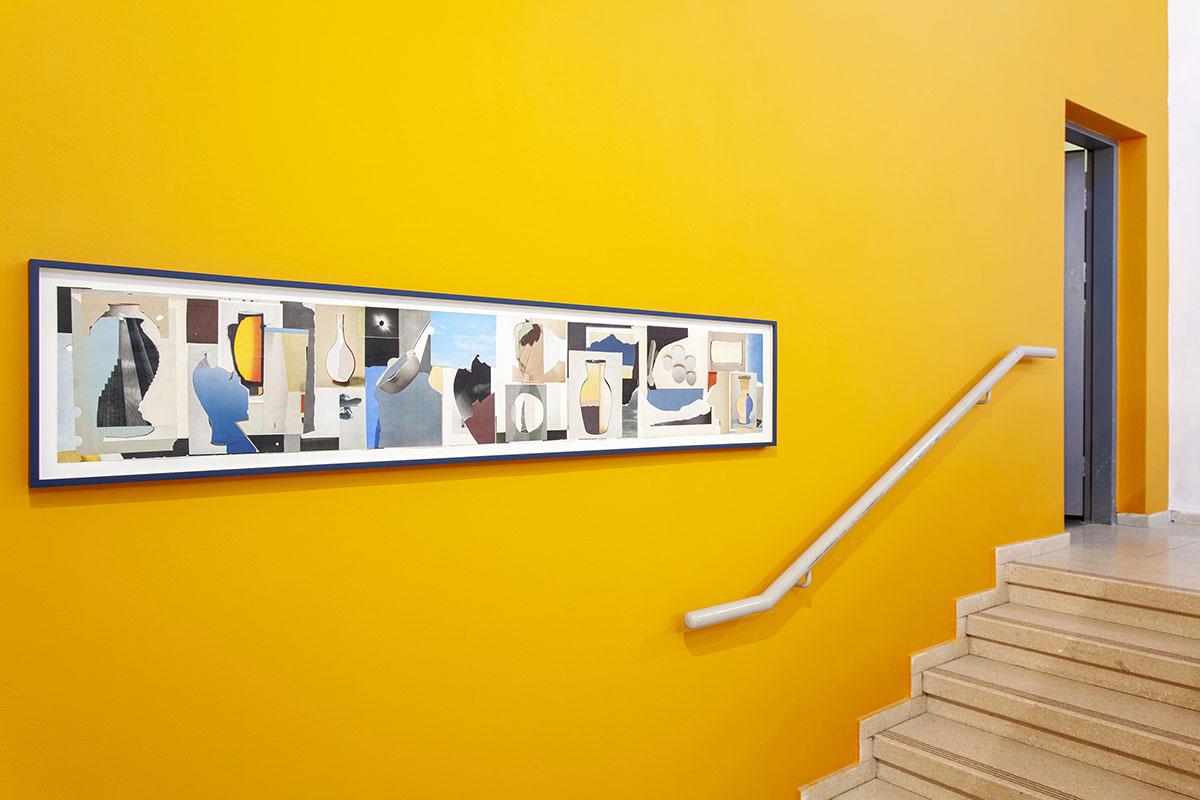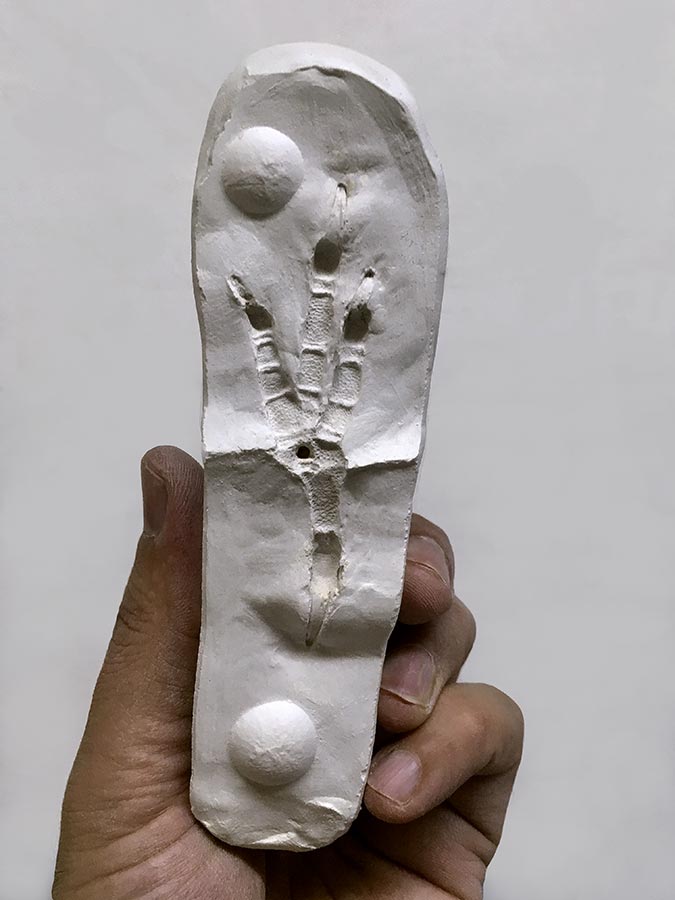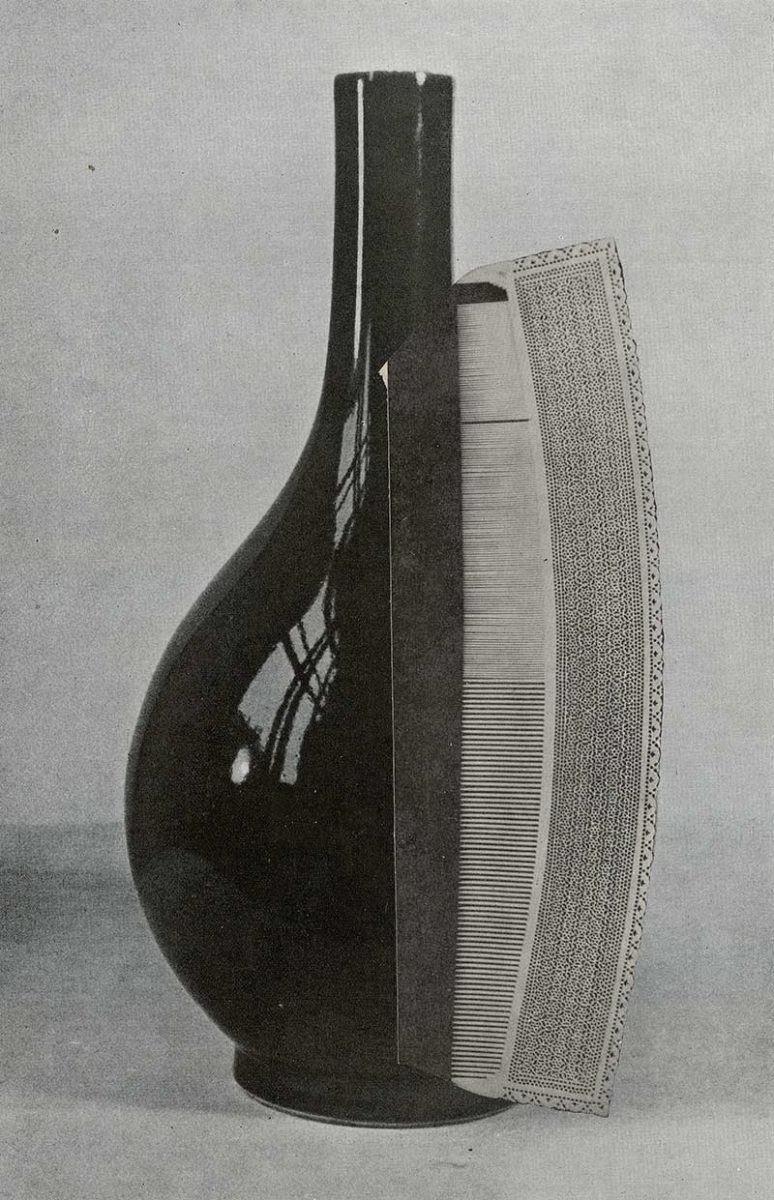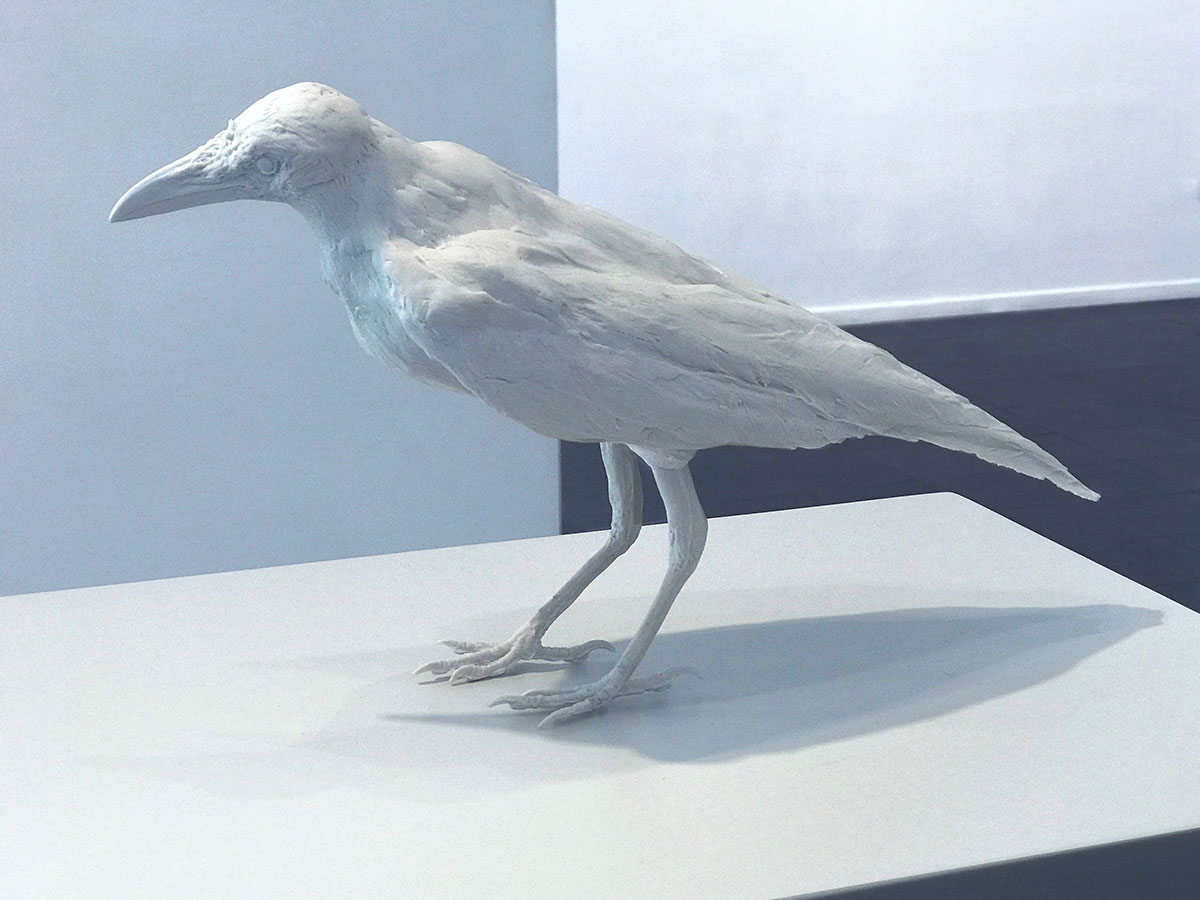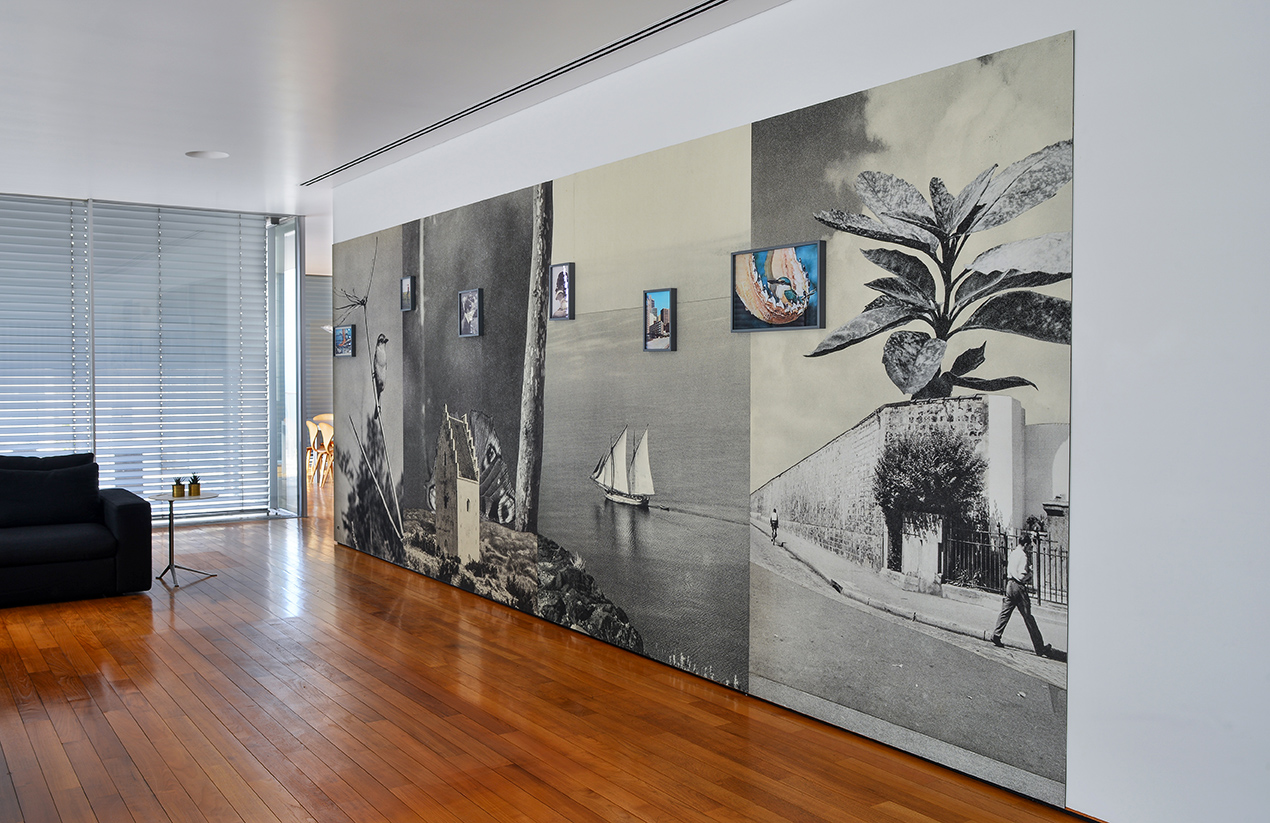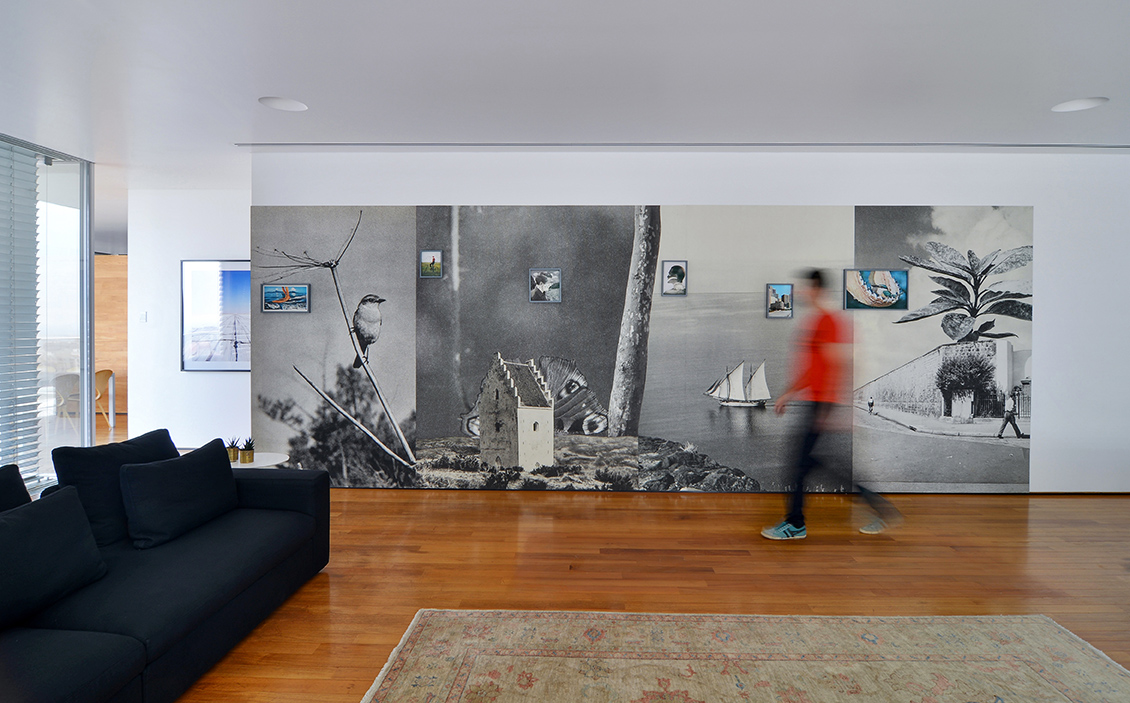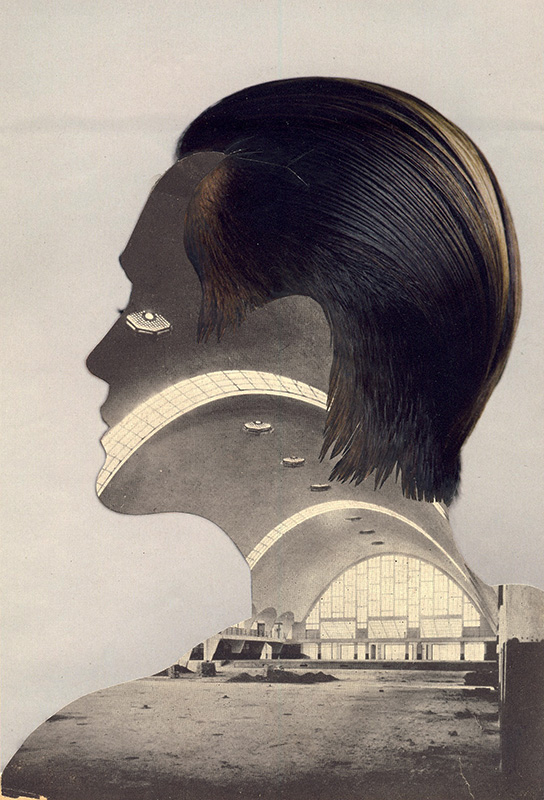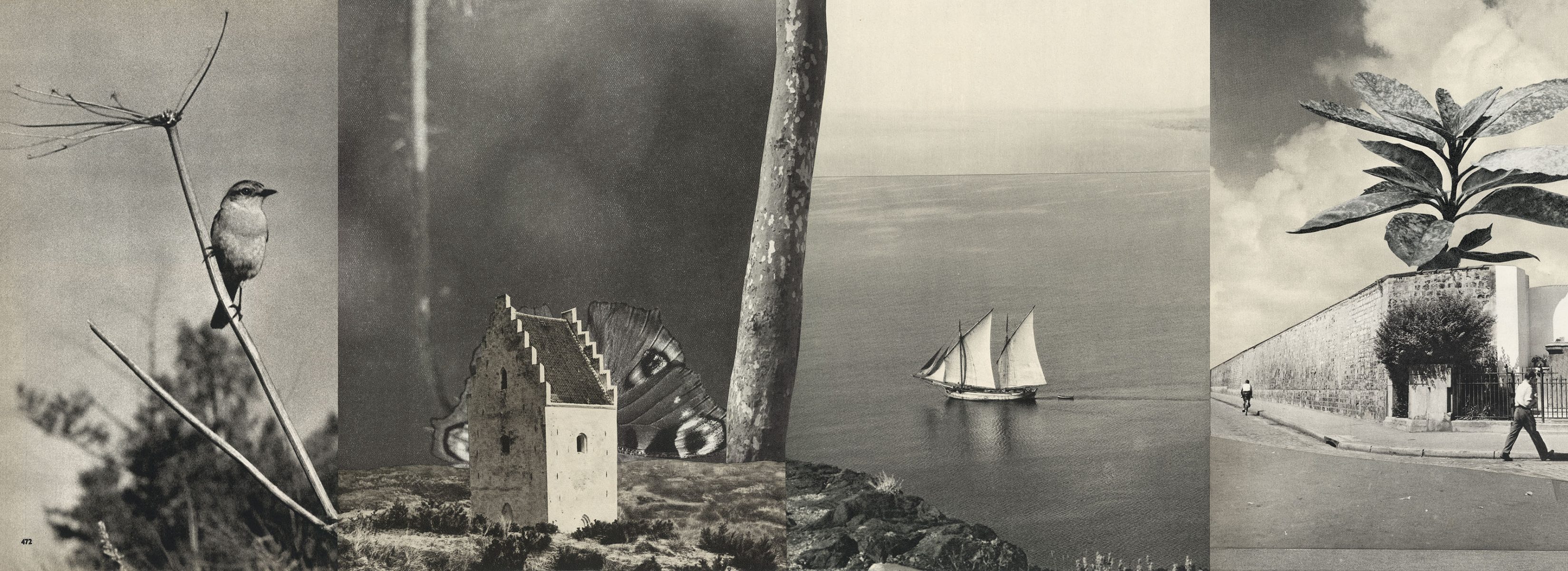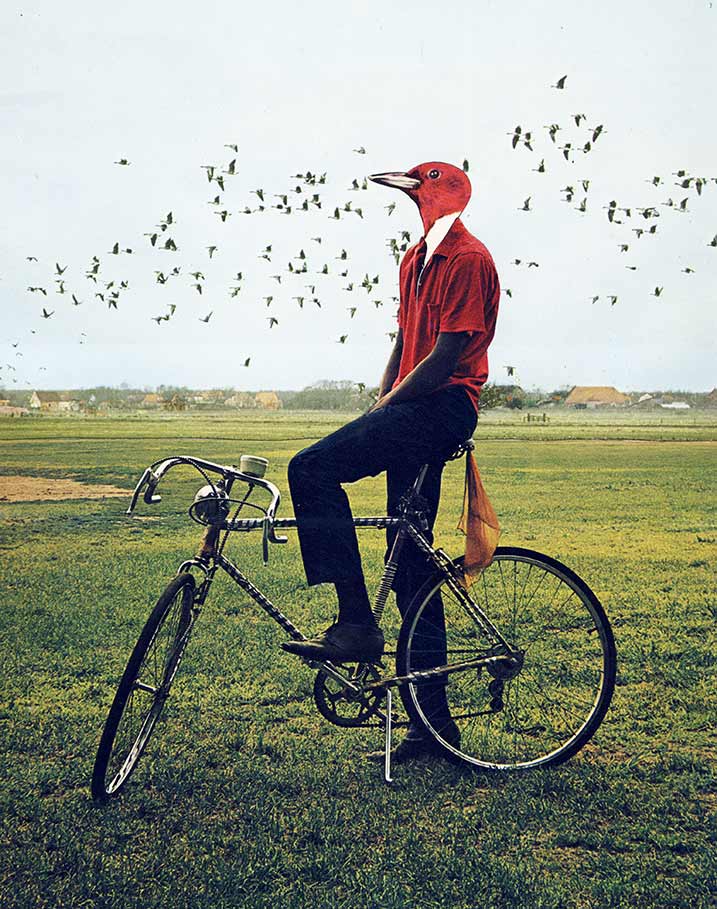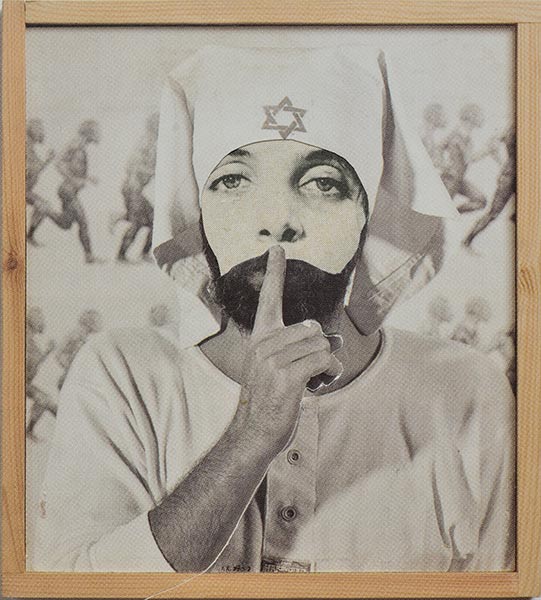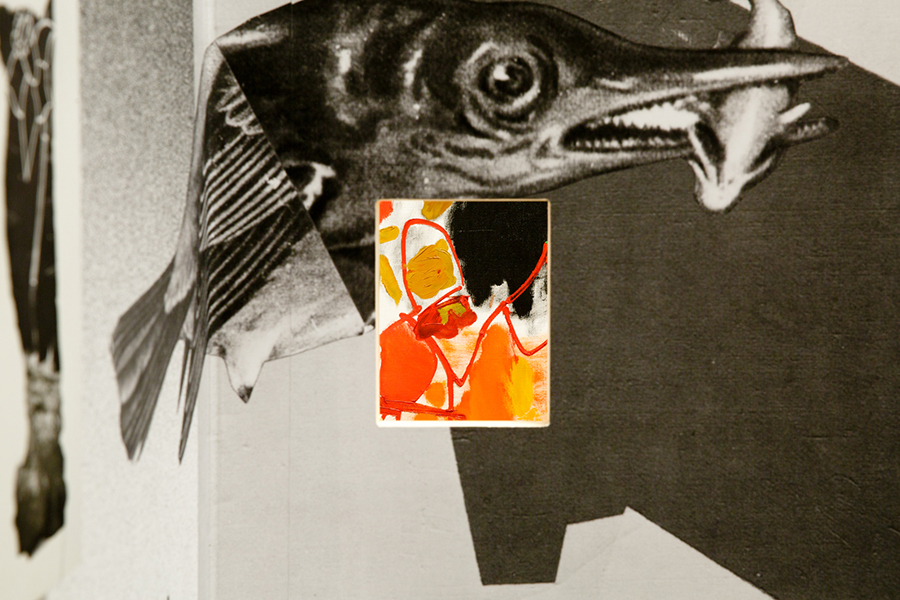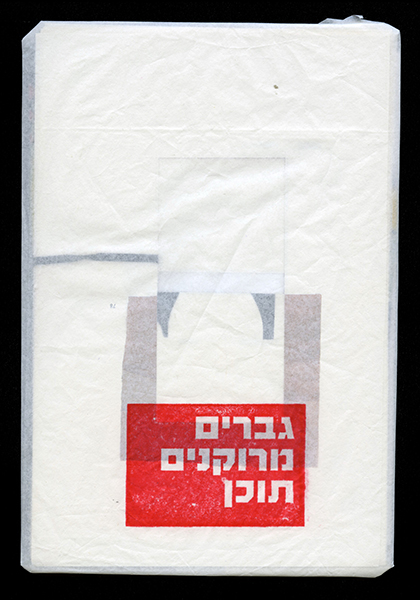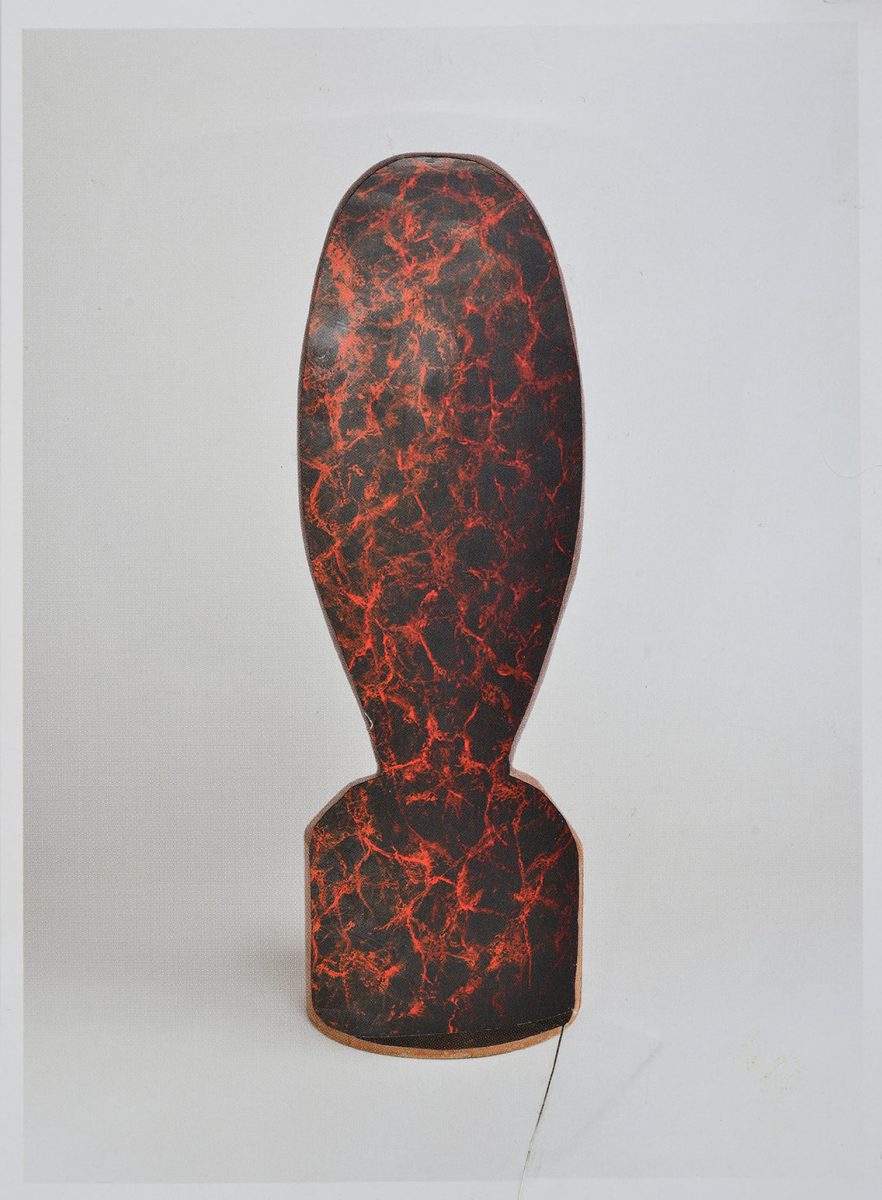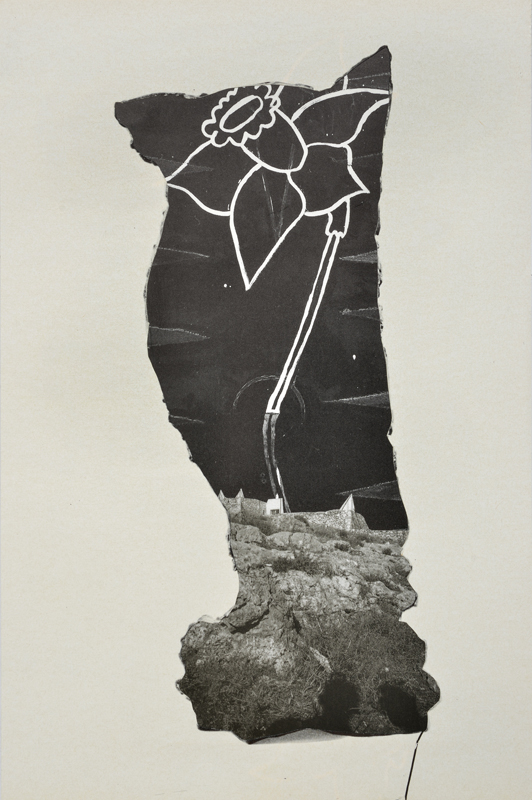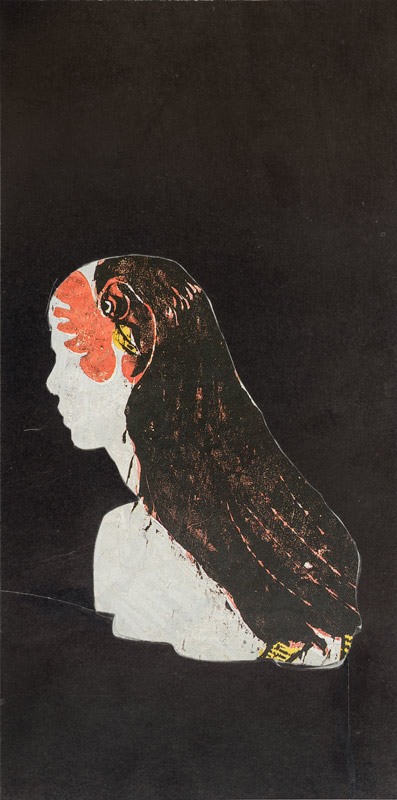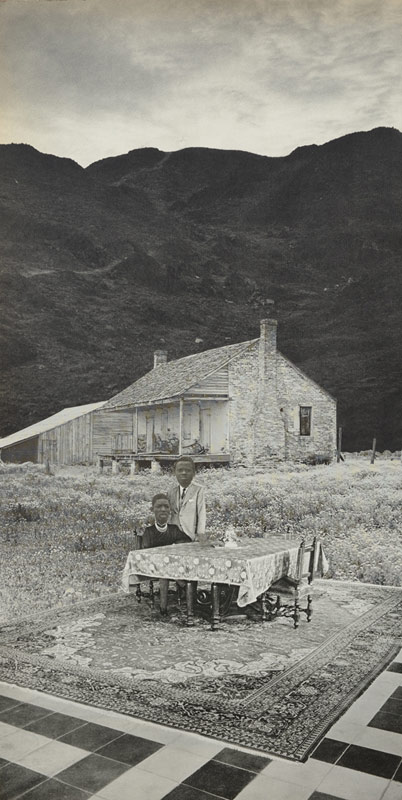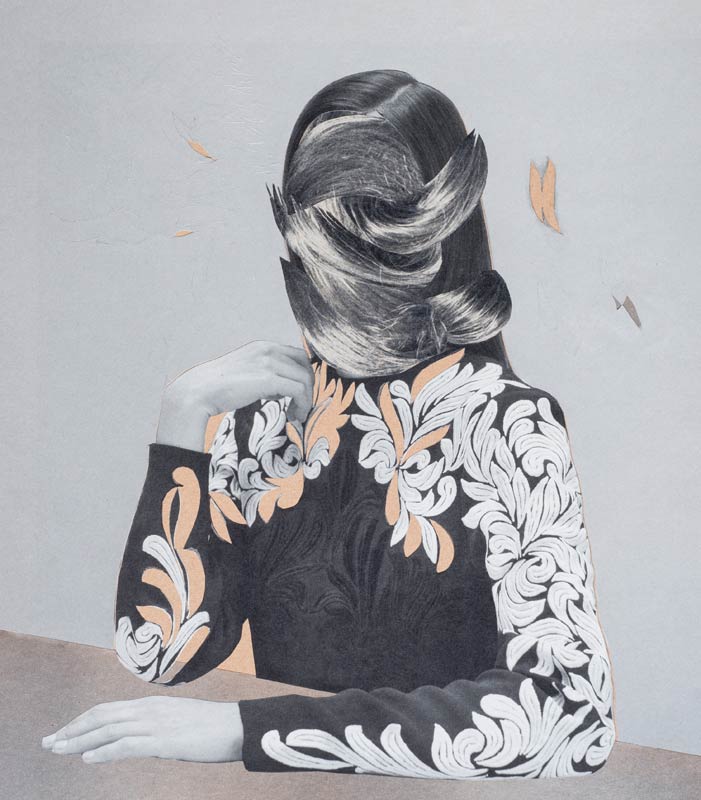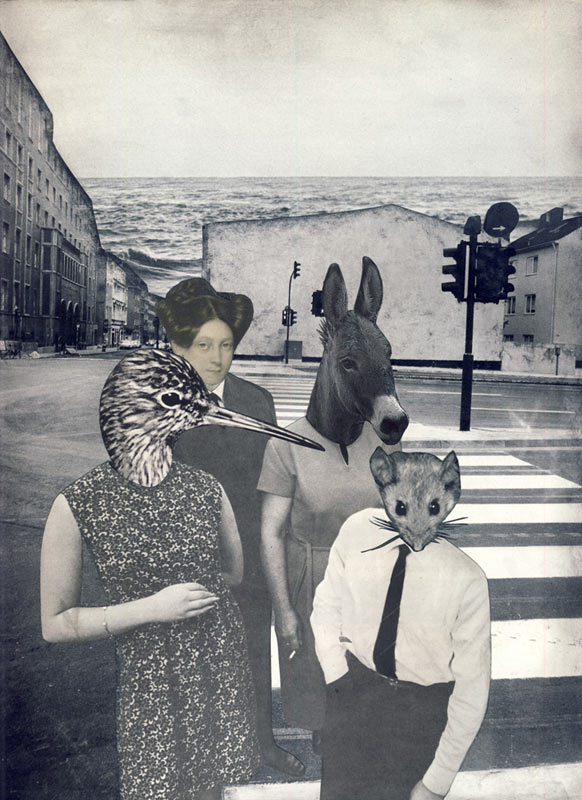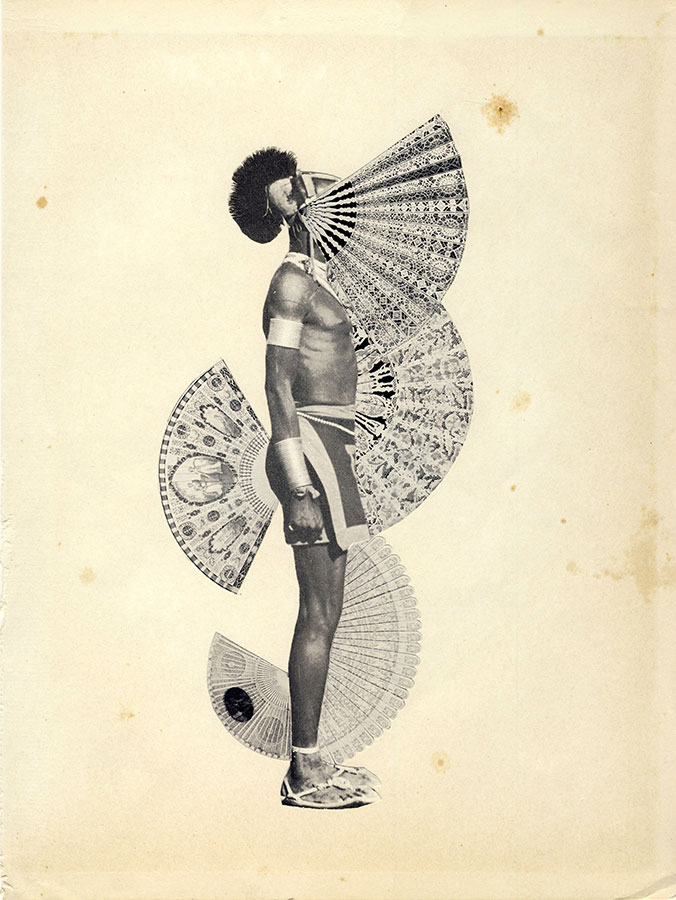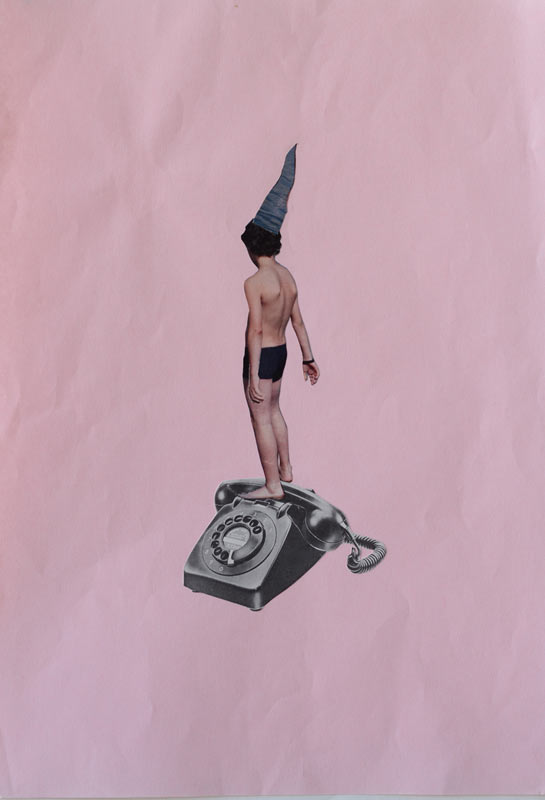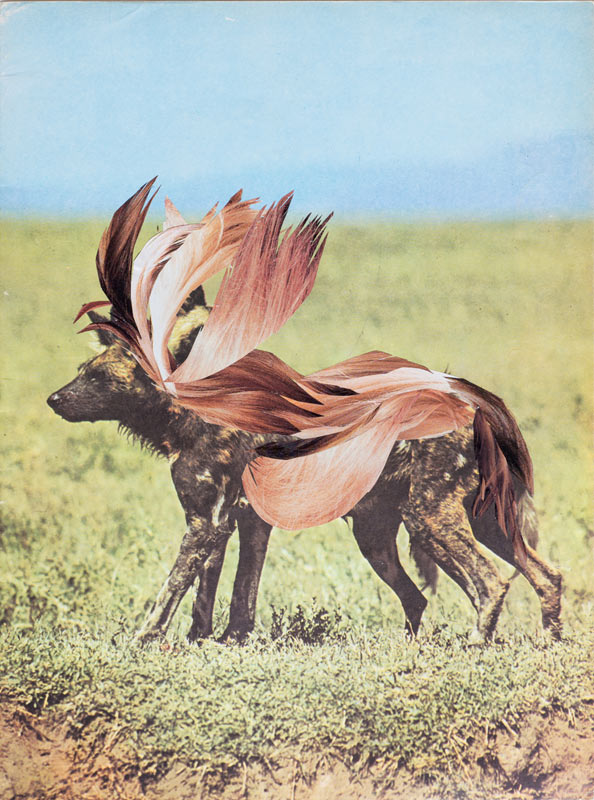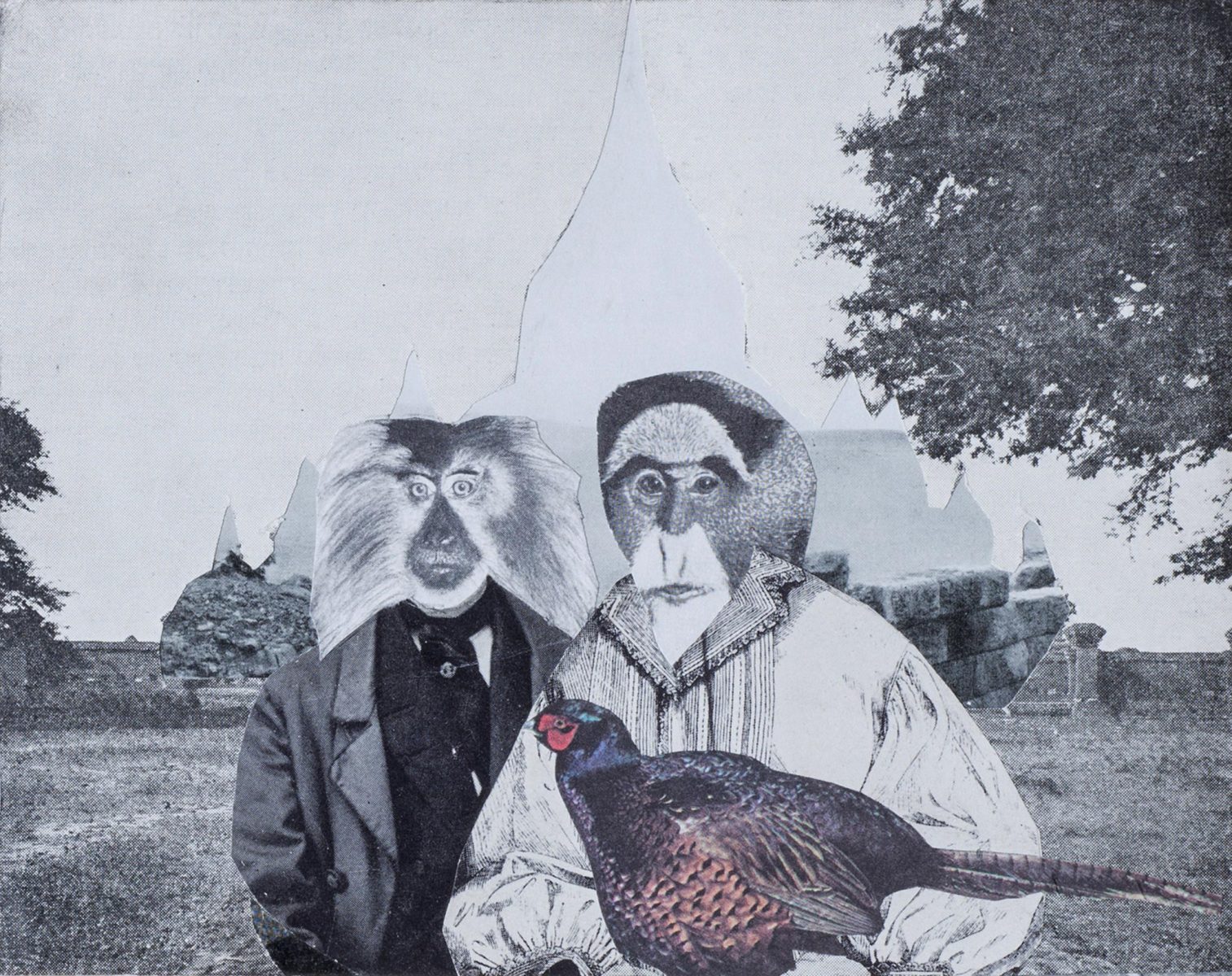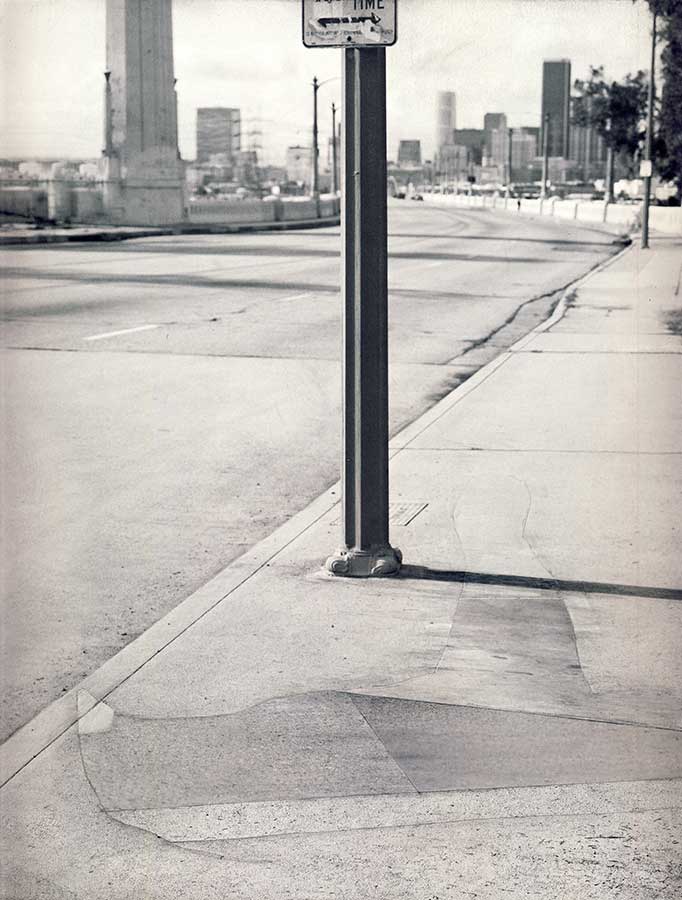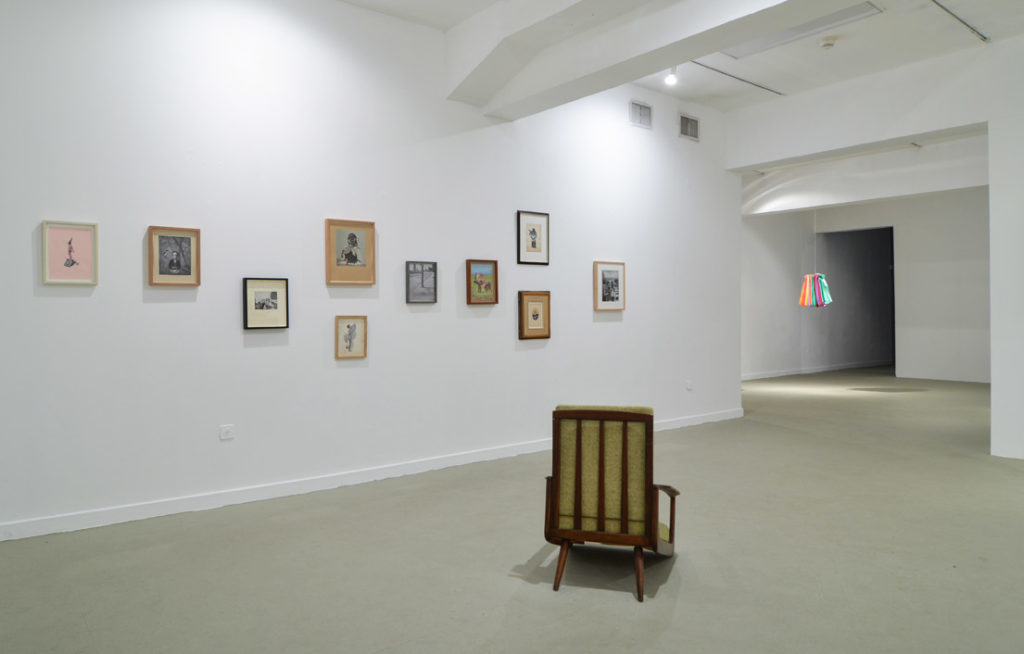Itinerarium
In his collages of found photographs, accumulated in notebooks, Shay Zilberman outlines a cartography of wanderings, a roadmap created in movement. He offers a possible cosmology of the imagination, which begins in the material meeting points of images, in the points of connection between viewers, images, and the systems that repeatedly ask to hold their meanings and are denied. This artist book offers a view into this internal logic, as a journey of discovery that simultaneously tears apart, reconstructs and maintains images, their histories, and the possibility to experience and encounter this plurality of presence.
Editor: Rotem Rozental
Designer: Aviv Lichter
Text by: Rotem Rozental, Matthew Schum and Aline Smithson
115 Pages, Text in English, Hebrew and Arabic, Self published, Tel Aviv, 2023
Calligraphic Animals
The Israel Museum, Jerusalem, 2023
Shay Zilberman’s Calligraphic Animals and Untitled collages feature imaginary totems and hybrid creatures that were created, not with a calligrapher’s pen, but with a pair of scissors. Working by hand, Zilberman meticulously and seamlessly combined different animals parts. His images base themselves on pre-digital representations of culture – traces of memory as found on the pages of photography books and nature guides. The result: an amalgam of mythological monsters and newer fantastic beings, influenced by Islamic calligraphy and miniature paintings.
Extracting his source images from their original factual contexts, Zilberman takes them into the realm of fantasy and conjures up an imaginary, mysterious, and possibly futuristic natural world of cloning and genetic engineering. His radical “mutations” are disturbing, but their beauty and swirling intricacy are also mesmerizing. Although black-and-white, they are surprisingly luminous, their light shining out of the printed photographs. Zilberman scoured his nature books for what he calls “symmetrical” images involving “eye contact” between the lens and the animal’s gaze, saying, “The moment an animal is photographed head-on, it is possible to lock gazes with it, and that precise moment remains, connecting the work and the viewer.”
Curator: Talia Amar
From the group exhibition: Facing the Wild – The Jungle Book Revisited
Miniatures
Petach Tikva Museum of Art, 2023
German Dada artist Hannah Höch was among the originators of photomontage in the years following World War I, a technique based on the creation of new pictures from existing, mainly photographic, images extracted from magazines, newspapers, and other printed matter, which are cut-and-pasted, combined, and manipulated, much like collage. The Dada artists made photomontage a major vehicle to disseminate criticism and protest, as it enabled decontextualization and defamiliarization of reality documentation, imbuing it with nonsense and absurd aspects.
Shay Zilberman, who shares his date of birth (1 November) with Höch, has been conducting a long dialogue with the techniques of modernist collage, Dadaist photomontage, and printmaking, including Höch’s work. He uses these practices to form artistic modes reminiscent of those of an archaeologist and a researcher of contemporary culture. He maps the printed photographic images of the 20th century, culls and collects them, subsequently stitching them together surgically by cutting and pasting, to form a new work that reveals invisible realms, while concurrently criticizing the modernist concept of the present. Unlike the spirit of Dada, Zilberman’s works are imbued with 21st century melancholy with regard to modernity and with reflections on the relations of continuity and rupture between man and the environment. They invite the viewer on labyrinthine journeys in confined spaces, while observing man being reflected and swallowed-spawned in the infinite mirrors between reality and dream.
Höch’s linocut album was created early in her career (1915-1918), almost concurrent with the years in which she honed the photomontage technique. The works most identified with her, created in the 1920s during the Berlin Dada days, were characterized by anti-bourgeois and gender political criticism, including a surrealistic-humorous engagement with the woman’s body and place in German society of the time. The album’s prints represent another facet of her oeuvre: compositions originating in the figurative, which reach the abstract; ornamental, expressive miniatures that capture the formal harmonies of a landscape.
Höch worked for about a decade as a graphic designer for handicraft magazines, and the textile-related thinking of weave and pattern is evident in her work, as well as in the early photomontages, and especially in the linocuts. Zilberman, who after studying at the Beaux-Arts de Paris attended the Fashion Department at the Royal Academy of Fine Arts, Antwerp, presents new works that converse with the linocuts in the album Miniatures belongs to The Israel Museum collection. These works—partly abstract compositions from layers of colored paper—echo modern embroidery and textiles, with an occasional image popping out of them. These are juxtaposed by monochromatic figurative compositions, in which the human, the animal and the vegetal are intertwined. Zilberman’s works engage in an intimate dialogue, which converges into miniature compositions, while extending over historical and personal time. The time of the imagination and memory seems to be physically present in the space of the paper, as though the medium, the form, and the image try to forget their initial modes of creation, so they may be reborn and thus produce a different view of the world.
Curator: Irena Gordon
Crystal Clear
Inga Gallery of Contemporary Art, Tel Aviv, 2023
Where I’ve Never Been
Tel Aviv Artists House, 2022
Ann and Ari Rosenblatt Prize exhebition for Visual Art in Israel 2021
Curator: Orly Hoffman
Link to the catalog [PDF]
The First Decade
Jaffa street gallery 97, Jerusalem, 2022
Israel – The First Decade is an Israeli photo book from 1958 that was common in almos every home in the country. This album features shots by Israel’s foremost photographers at the time, and showcases the new state’s vision and burgeoning aspirations. No national aspect is ignored in the album’s many images: agriculture, employment, education, religion, medicine, industry, army, archeology, culture, leisure, bereavement, and more.
This book, gone from public consciousness but still available in many secondhand stores alongside similar albums from the analog age, serves in this exhibition as the sole source matter for a series of manual collage works using only scissors and glue.
In working on this series, Shay Zilberman gutted Israel – The First Decade of its constituent images, dismantled each image into its details, and reorganized the details into a new typological collection of groups and subgroups. The collection served as raw material for the collages, both as canvas and as the elements making up the final image.
The connections created suggest a re-reading of the familiar clichéd images. Reorganizing the album based only on images taken from it illuminates the logic of this politically co-opted book, and deliberately upsets the nostalgic gaze natural to this sort of memorial album. Thus, it seeks to dust off the album’s pages, proposing an alternative contemporary and poetic reading that raises quintessential questions of identity, place, time, and the power of the gaze.
As an artist working in Israel who grew up here in the late 1970s, Zilberman started out discovering the world through photo albums, of the type that used to be in every home, and which presented Israel and the world as objects of desire. The artist dedicates the series shown here to that point in time, when images generated an experience of discovery – the product of journeys that took place for him then, and continue to take place between the pages of the photo books.
Artistic Management and curating: Asaf Cohen and Izek Mizrahi
Concertina, Machin’s rhythm
Zumu, Museum on the move, The Zogloweck factory, Nahariya, 2022
Shay Zilberman created an intricate concertina especially for Zumu Nahariya out of ten collages dealing with subjects relating to life and the factory.
Zilberman, who collects images from abandoned books and breaths new life into them by connecting them, manages to magically merge images from disparate and diverse worlds into a concise and powerful language of imagery.
His concertina (an accordion-like collection of pages) resembles a production line in a factory on which different images are placed, which have been created out of mysterious collages. Zilberman connects, with great ease, the living natural world to industry, mechanics to concrete or man to machine to create new imaginative hand-made images through hard, meticulous work.
Curator: Shua Ben Ari
Fasadas
Central Post Office of Kaunas, part of Modernism for the Future 360/365 “Kaunas – European Capital of Culture 2022”
‘Fasadas’ establishes new ways to experience the historical heritage that glorifies the city and highlights the characteristic elements of facades. following the documentation of the original plans of 40 iconic and less known selected projects, the artist created a series of digital drawings, a new visual and graphic lexicon based on the frontal view and contours of the buildings, similar to the blueprints made by the architects which were designed and drawn on paper. Later the drawings went under digital processing and were cut, resulting in a series of stencils made of plexiglass. The exehbited work is a series of paper collages in which the acumuleted lines shapes and figures merge into an imaginary grid, an alternative, poetic, research-based depiction of modernist Kaunas.
Curator: Viltė Migonytė
Front Crawl
Art Cube Artists' Studios, Jerusalem, 2021
In this duo show, artists Shay Zilberman and Chen Cohen cross paths and interweave with one another. Video, collage, photograph, sculpture, or textile – their works are interconnected, bound by a relationship of exchange and reciprocity. Thoughts interlace, body meets body, the practice of one is appropriated into the practice of the other. Trading images and dreams, they imbue their work processes with one another.
They collect and exchange sources of inspiration – discarded objects, books, and photos, but also rocks, fossils, animal bones, and other natural remnants. Zilberman and Cohen reach beneath the surface and under the skin, gathering human waste – both urban and corporeal. They photograph, scan, cut, paste, or sew the objects that history left in the lower strata of the universe, and the secretions and residues that the body carries from the depths out to the uppermost layer.
They train together, teaching one another techniques, soaking up mediums and habits. Each artistic and quotidian action is a potential for a documented performance or a physical display. The two also train together in front crawl swimming. Their bodies stretch and elongate, picking up speed to counter the water resistance, pushing through, pushing against, undermining, generating transformation – in themselves and in everything that comes in contact with them. Exposed beneath and above the water, their bodies carry private mythologies, moving while completing body parts and assimilating gestures and ideas that informed their previous solo shows but remained hidden from view. Now, they are exposed as the creative mechanism of two artists and a curator, who have been engaging in an ongoing years-long conversation.
Ilanit Konopny
As part of Manofim Jerusalem – Contemporary Art Festival
Exhibition catalogue [Pdf Hebrew Arabic English]
Harrama magazine (Hebrew)
The Parted Sea
Artist Hotel Tel Aviv, 2020
commissioned work
Solvent print and inkjet print on paper
Curators: Dana Golan and Dina Yakerson
Garden’s Keeper
Inga Gallery of Contemporary Art, Tel Aviv, 2020
Click here to discover the show
Tell
Hacubia Contemporary Art Gallery, School of Art, Jerusalem, 2020
An archeological mound – “tell” – is an artificial hill that was created from several layers of ancient ruins. Sharan Elran’s and Shay Zilberman’s duo exhibition at Hakubia gallery presents a contemporary-artistic interpretation of a “tell.” Elran, a computer science researcher and digital ceramicist, and Zilberman, a collage artist, joins together for a mutual exploration of local archeological findings. Three local ancient vases dated between the tenth and seventh centuries BCE, serve the artists as fertile ground for deconstructing and reassembling forms and lines carrying prior, ancient knowledge.
The ancient vases are not physically present in the exhibition. Their spirit––ghosts of the past––is embodied in the various interpretations offered by the artists, the result of an ongoing research, a layered process of trial and error.
The timescale is stretched throughout the exhibition as an implicit, delicate line. The surface level reveals the new, shiny, framed, clean and protected. A more nuanced and attentive examination would slowly lead the viewer/archeologist to what is underneath the surface: the scanning and cutting lines, the history of the artistic action, and the quiet drama of the historical image buried deep beneath the “tell.”
Curator: Dan Ormian
Exhibition Text by Noga Bernstein and Dan Ormian [Pdf Hebrew]
Tel Aviv: From the seafoam and clouds to the here and now
Providence College Galleries, 2019
Shay Zilberman employs the art of layering to showcase a kind of urban alchemy cultivated by artists, architects and broader society. His every artwork meticulously pieces together carefully sourced mid-century magazine pages and layers of paper, parchment and pigment. Alternating between collages made of historical imagery and unique prints composed of color blocking, his overall oeuvre represents the ways in which individual and collective memories of places differ from reality. Using making techniques that are as precise as they are intuitive, Zilberman becomes a kind of imagistic storyteller, documenting and speculating on the built environment’s promise and failure to improve its users’ quality of life.
For Tel Aviv: From the seafoam and clouds to the here and now, the artist created works on paper that manifest connections between the past and present states of Tel Aviv’s International Style buildings. Whether with collage or chine-collé print, the multiple layers and juxtapositions of his compositions poetically synthesize the imagined histories of the White City with the diverse realities of Tel Aviv today. Many of the building parts pictured in the collages and prints were documented in the 1930s. Today, they usually look completely different because of neglect, the damage that comes with time, or the alterations made in service to later additions and decorative features. The fantastical towers shown in Untitled (Postcards from Tel Aviv) all at once conjure the utopic yet unrealistic ideals of Bauhaus design. They most directly reference the various towers that spring up all over tel Aviv on a regular basis. Zilberman’s re-imagined buildings gussy up archival photographs not to preserve them, but to instead highlight societies’ strangely constant re-creation of the tower of Babel. With this, he consciously brings together the multi-culturalism of biblical Babylon and contemporary Tel Aviv with the socialist values that informed the International Style and the capitalist real estate interests that currently profit off the White City narrative to power the tower projects of today.
Curator: Jamilee Lacy and Dr. Revital Michali
Participating artists: David Adika, Ronny Carny, Yael Efrati, Hilla Toony Navok
Garden of Hope
Rishon Le-Zion Museum, 2019
Shay Zilberman’s work is derived from the place itself: he produced a new glass interpretation of the iron bell in the Museum’s collection. As the 19th century drew to a close a bell was placed in the middle of the Moshava Rishon Le-Zion, but it was stolen from the Founders’ Square in 1960. All efforts to retrieve it, including a public appeal launched by the Rishon Le-Zion municipality and even the hiring of private detectives by the Municipality failed to trace the bell’s location. It was only after more than fifty years during which time the bell was buried under the ground that it was surprisingly returned. After reaching the age of seventy, the thief decided with the help of a mediator to return the bell.
The bell serves as a symbol of freedom, trust, hope or victory, and is presented here as a fragile sound box. Alongside beauty and transparency the bell also embodies the forlorn prospect of self-destruction. A group of anonymous portraits of people who share a common secret are exhibited on the walls. This is an imaginary list of fifty people, whom researchers believe held back information about the missing bell.
Curator: Dana Arieli
Souvenir
Wilfrid Israel Museum of Asian Art and Studies, Kibbutz Hazorea, 2018
Shay Zilberman explores mediated images and the historical and cultural narratives they contain. The eclecticism of the Wilfrid Museum’s collection has been a fertile ground for his activity; he responds to the uniqueness of each and every object and highlights it. Zilberman barely refers to the original meaning of the objects he has chosen, but to the range of meanings and possibilities that is imbued in them. He took objects from the museum’s collection and recreated them – similar but not identical – combining state-of-the-art techniques – 3D scanning and printing – with traditional, labor intensive craftwork, such as porcelain casts. Thus, two statues from the collection – a clay burial statuette of a Semite merchant from the Chinese Tang period (7-10th centuries AD) – and a miniature brass statue of a traveler (Greece, 3-1 centuries BC) have been recast as modern-day garden gnomes, protectors of the land. Similarly, a Chinese bronze burial mirror from the Han period (late 3rd century BC-3rd century AD) has been turned into a wheel.
Charging the sculptures with new and different meanings undermines museum practices that enshrine the linear cultural history of objects. In Zilberman’s work, objects that hold together cultural-historical memory are removed from their natural location, and their very arrival to museums in various places in the world turns their narrative into an imaginary one.
In his actions, Zilberman annuls not only hierarchies of time, size and place, but also our need for a fixed and well- defined historical narrative. He creates collages from old postcards and photos that he finds in old history and culture books. These are cut and pasted to jointly create an object that seems familiar in its materiality and maybe even form, but nevertheless its attribution to a specific narrative is not immediate nor straightforward. The objects – originally important enough to appear in books as representatives of culture – are interweaved, their materials and colors become one, a kind of imaginary time capsule, and their meanings become poetic rather than specific.
At the end of the hall hangs a collage enlarged and remodeled into a tapestry, in a process that combines Jacquard weaving with modern technologies. The collage, essentially a collection of images, is reinvented as a single museum object that dominates the space. A Chinese bronze vase is split up and lies on its side, at the center of which there is a ball, which is in fact a mace head made of hematite (Chalcolithic period, 4th millennium BC). The collage seems like a huge eye staring at us, like the eye of a Daruma Doll, while the other is waiting to be completed.
Curators: Rotem Ruff and Anat Turbowitz
Hunting West
Inga Gallery of Contemporary Art, Tel Aviv, 2018
A Wall In The City
The southern wall of Tel Aviv-Jaffa city hall, 2018
commissioned work
Shay Zilberman’s work draws on his private archive. For years, Zilberman has been collecting black and white photographs from old books and journals, cataloging them by themes. From this rich and diverse collection, he picks out images, compiling them in a labor-intensive process of cutting and gluing into new – deceptively harmonious and organic-looking – compositions. The collages presented here are architectural amalgamations of Israeli and international buildings, some of them are easily recognizable and others only look familiar. Among them we can identify a wide range of architectural styles from different eras and places – from Brutalist architecture in Tel Aviv to architecture in Japan.In his work, Zilberman unfolds his perspective on the city by using the perspectives of other artists, most of whom are anonymous photographers. As an alternative to the abundance and surplus of images that dominates our reality, he chooses to work only with images from the printed media. The use of old books and journals that bear the traces of time, invokes a ready-made nostalgic element: the fictitious landscapes Zilberman creates from existing sites evokes a feeling of déjà vu, conjuring up places we have already been to.
In order to weave the different images into the new piece, Zilberman uses manual technique of cutting and gluing, without the use of computer. He applies another manipulation on the images with discrete drawing interventions. Ink and graphite serve him as tool for erasing or filling in identifying markers in the original image, in order to open more possible options of reading for the viewer.
The enlargement of the pieces to the size of the wall, underscores the material diversity of the print materials and the handmade nature of the collage. The power relations between nature and the architectural motifs, the strength of one versus the fragility of the other, also come into the fore here. The work wishes to mediate the existing dialogue and amplify the tension created in this encounter. The project A Wall in the City addresses the southern wall on which it is displayed as a physical and mental space. A photo of Tel Aviv City Hall is incorporated in the collage, with deliberate disruptions, together with other sites that will be familiar to local viewers. The wall spreads like an imaginary urban scroll, inviting the viewer to discover it while walking alongside it.
Men Gaze at Water
Tel Aviv Artists' Studios, 2018
The core of the exhibition Men Gaze at water is in a collection of photographs originated from various magazines and books. This basic romantic theme seems ironically an impossible one as all these situations of contemplation, expectation and wondering relate to different locations and time periods.
They are countered by the use of imagery related to Christian iconography: casts of body fragments reminders of relics, and the reoccurring notion of water.
About the exhibition in Asylum Arts Magazine
Text by Oded Wolkstein in Erev Rav Magazine (Hebrew)
Curator: Vered Gani
Crystal
Oranim Collage, The Gallery for Israeli Art, Qiryat Tivon, 2017
The Return of the Pilgrim
Traces VI, The Sixth Biennale for Drawing in Israel, Jerusalem Print Workshop, 2016
Shay Zilberman’s point of departure is the place, the space. He models the space of a scholar, a romantic, and a collector. The site-specific paper installation in the current show, The Return of the Pilgrim, is tantamount to an inner nature creeping and swarming in a room at the Workshop facing east, toward the Temple Mount, the realm of sanctity, a millennia old place of pilgrimage. Zilberman operates like a paper pilgrim who extract and cuts existing images from magazines, periodicals, encyclopedias, and illustrated books, combining them by means of manual “Photoshop” and intervention in graphite and ink drawing to form hybrid, surrealistic landscapes—dreamlike scenery which holds the time and history of different places brought together. The books serve him as mediators of the world, and paper is the tool by which he creates life. In a collagist act that may be described as gardening, he “grows” a new landscape through the paper, at once nostalgic and disconcerting.
Curator: Irena Gordon
Private Commission
Installation view, Tel Aviv, 2015
Men Emptying Content
Mixed-media and live event presented during Contact Point, the Israel Museum, Jerusalem, 2015
Along the walls in one of the exhibition halls of the Israel Museum a temporary parasite structure has emerged for one night only. Placed at some distance from the walls, and parallel to them, this wooden structure was mounted with a panoramic sequence of collages in varying formats. The collages, sourced from reproductions originating from the museum’s own reservoir of Israeli art catalogues, rearranged the original images into new hybrids. The collage cycle still allowed a glimpse into the works hung behind it – masterworks by the likes of Arikha, Lavie and Schlezniak.
At the center of the space, a group of seven men was at work throughout the evening, employed at cutting the images out of the very same depository of catalogues. The men systematically reassembled the images they cut into a large paper blanket that kept growing as the evening progressed: a “patchwork” of multicolored art reproductions.
The process created a bulk of leftover white pages that were emptied of their images, leaving large window-like holes in their midst. These were bundled together, wrapped in paper and labeled, to be given to the audience in attendance.
Artistic director: Renana Raz
Featuring: Nadav Eisner , Mauricio Einhorn, Yonatan Franzus, Gur Kitai, Yonatan Stern Novitzky, Amir Eliad, Rei Raviv and Niv Hirschowitz
True to original
Site specific Installation, Herzliya Museum of Contemporary Art, 2015
The work on view portrays a disconcerting, fictional natural landscape populated with fantastic hybrid creatures, such as bird-people, recalling the illuminated manuscript of the thirteenth-century. Zilberman ascribes great importance to his work process. He quickly scans book pages, locates the ones he deems most appropriate – depending on paper type and texture, as well as the image size and position – and then defaces and appropriates fragments from them. Finally, like an adept surgeon, he joins them together, creating a whole new, alternative reality. The materiality and condition of the printed papers, attesting to their former existence, are evident in the final image, expanding its meaning. The collage practice, surreal landscapes and hybrid figures may be understood as challenging power relations within the cultural and social order and as a reflexive contemplation on photography.The nomadic theme finds expression in various aspects of this work process, portraying the artist as a contemporary flaneur wandering among a multitude of images. The images are cut and combined with others in a way that makes their origin unclear while recontextualizing them in universal, intercultural settings.
The artist’s journey resonates with his moves, indicating points of disconnection and connection among the “treasures” he has gleaned from the originals he has visited. This gathering may be regarded, in light of Deleuze and Guattari’s notions, as a territorial practice of the nomad artist – that is, marking his territory or ownership of the settings and objects he has come across in his journey. The eyes of the figures are covered, releasing them from their concrete existence and allowing the viewer to project his or her own personal world onto them. In addition, this covering effect undermines our viewing, raising questions as to what transpires beneath the surface. In addition, the panorama on the wall presents an inquisitive field of vision by not allowing the viewer’s gaze to see all of it at once. One is required to draw nearer and away again, each time re-encoding the details perceived and processing the images into a semblance of coherence. The various perception routes outlined through the panorama by one’s gaze generate diverse syntactic, subjective image sequences, which continue being woven as long as the gaze lingers.
Tal Bechler
Eternal Afternoon Nap
Inga Gallery of Contemporary Art, Tel Aviv, 2014
The Ten Lost Tribes
Untitled (The Ten lost Tribes), 2014
Photo-etching, embossing and ink on paper
29×39 cm each
Part of The Latest: New Works from the Prints and Drawings Collection, Tel Aviv Museum of Art
Shay Zilberman’s print continues his engagement with collage. As in the collage works, his raw materials are charged with history, and the way he treats them is always associated with the predigital world in which the work tools were scissors rather than Photoshop, and work was manual, attentive, and intimate. Seriality is also characteristic of Zilberman’s collages, but in print it is not only a flow of images from one another, but the creation of a ten-part whole.
The subtitle, The Ten Lost Tribes, alludes to the legend about the Israelite tribes exiled by Shalmaneser V, king of Assyria, “beyond the Sambation River,” namely—to an unknown place in the Assyrian kingdom; fearing desecration of the Sabbath, they were unable to cross the river—”the Sabbath River”—and return to their land. Zilberman became familiar with the story of Asians who believe they are descendants of the ten tribes. He cut portraits of Asian male models from magazines, and using scissors and glue, shut their eyes to present them in a state of sleep and dream—a meditative, even erotic, state which presents the far-fetchedness of the story and the interpretations attached to it over the years. The background was hand-colored, and plant parts which the artist gathered outside his studio—indigenous flora which ostensibly links the dreamers to the place—were incorporated in the men’s garments.
Curator: Irith Hadar
The Readymade Centennial
Haifa Museum of Art, 2013
Shay Zilberman creates his collages by combining existing images produced by various artists, most of whom remain anonymous. He cuts them from books, magazines and journals to create visual hybrids, surprising and exciting cross-breeds of images and materials. In the printed materials he finds, collects and acquires, the presence of time is prominent. The pages he works with are remnants of a material world that is disappearing, but he uses them to create a new world of his own. The very simple handiwork, which basically entails cutting and pasting, represents an extinct technique in a world that is controlled by Photoshop and its derivatives.
Zilberman’s focus on what exists and is commonplace suggests that everything has already been found and invented, and it only remains to choose and point at what is important. His approach to materials and images has an aspect of preservation, as well as ecological savings. Moreover, nostalgia is also readymade. The use of a manual technique and existing images rescues the technique and images from being lost and forgotten. And, nonetheless, in an unavoidable circular process, it brings new artistic objects into the world.
Curator: Ruth Direktor
